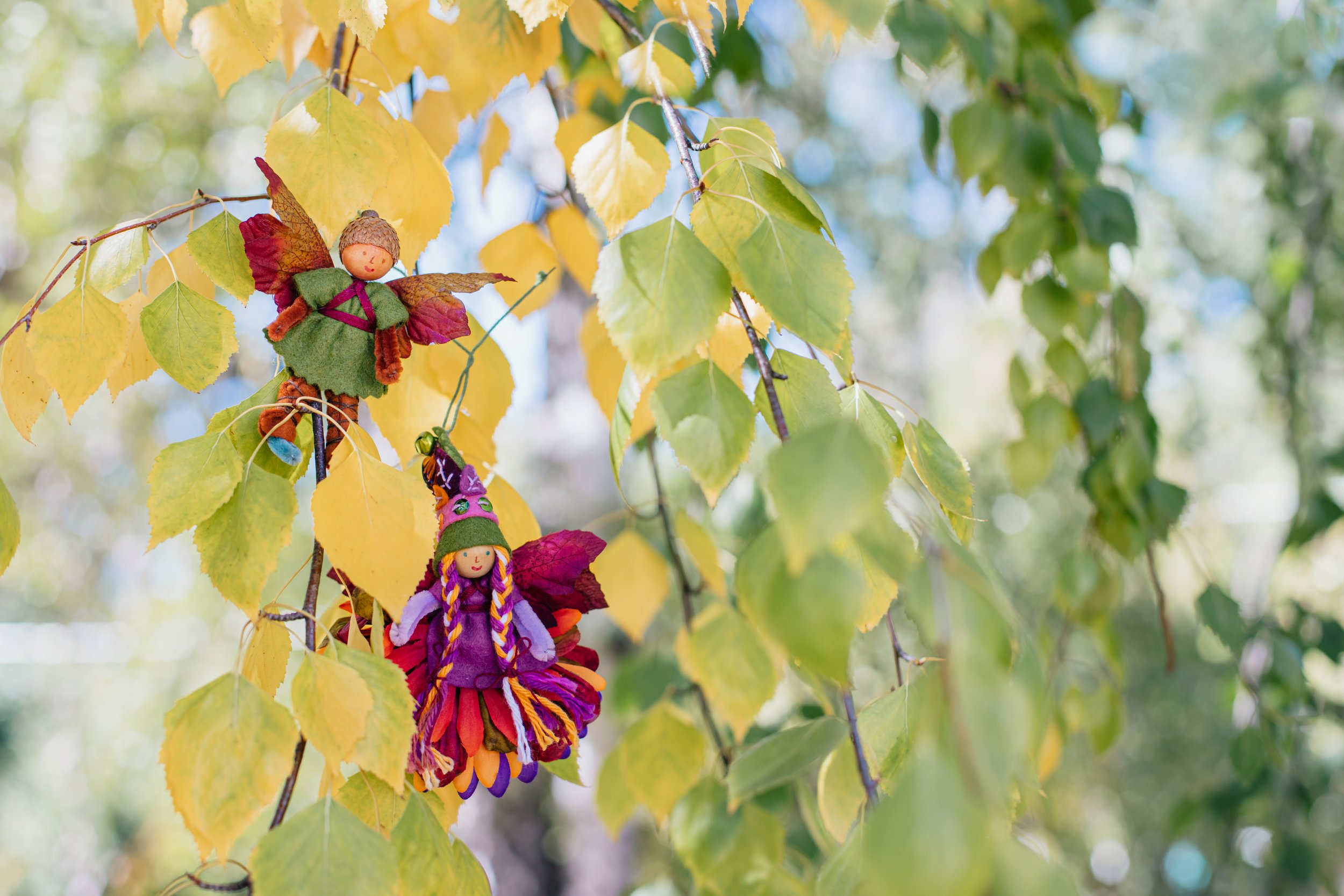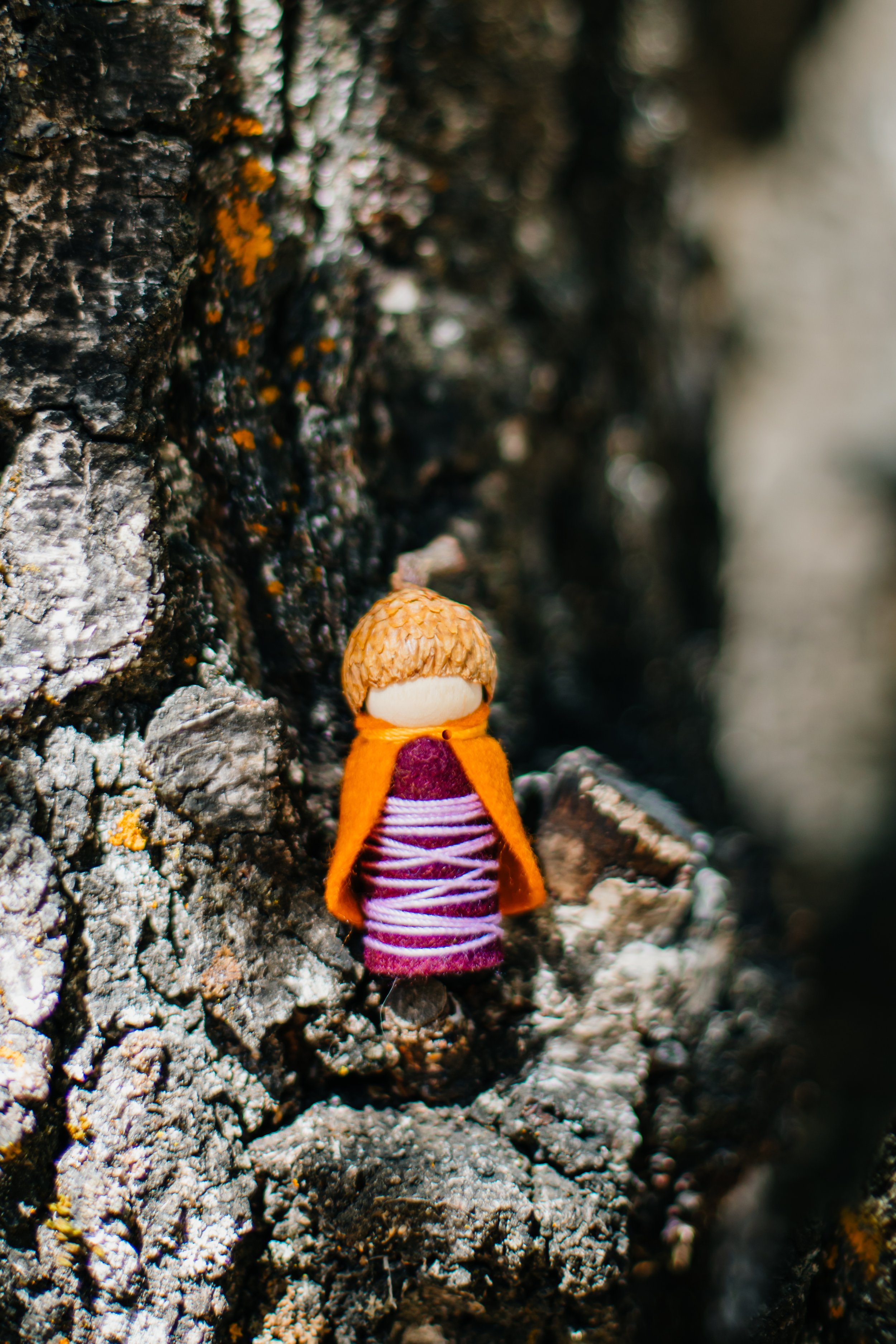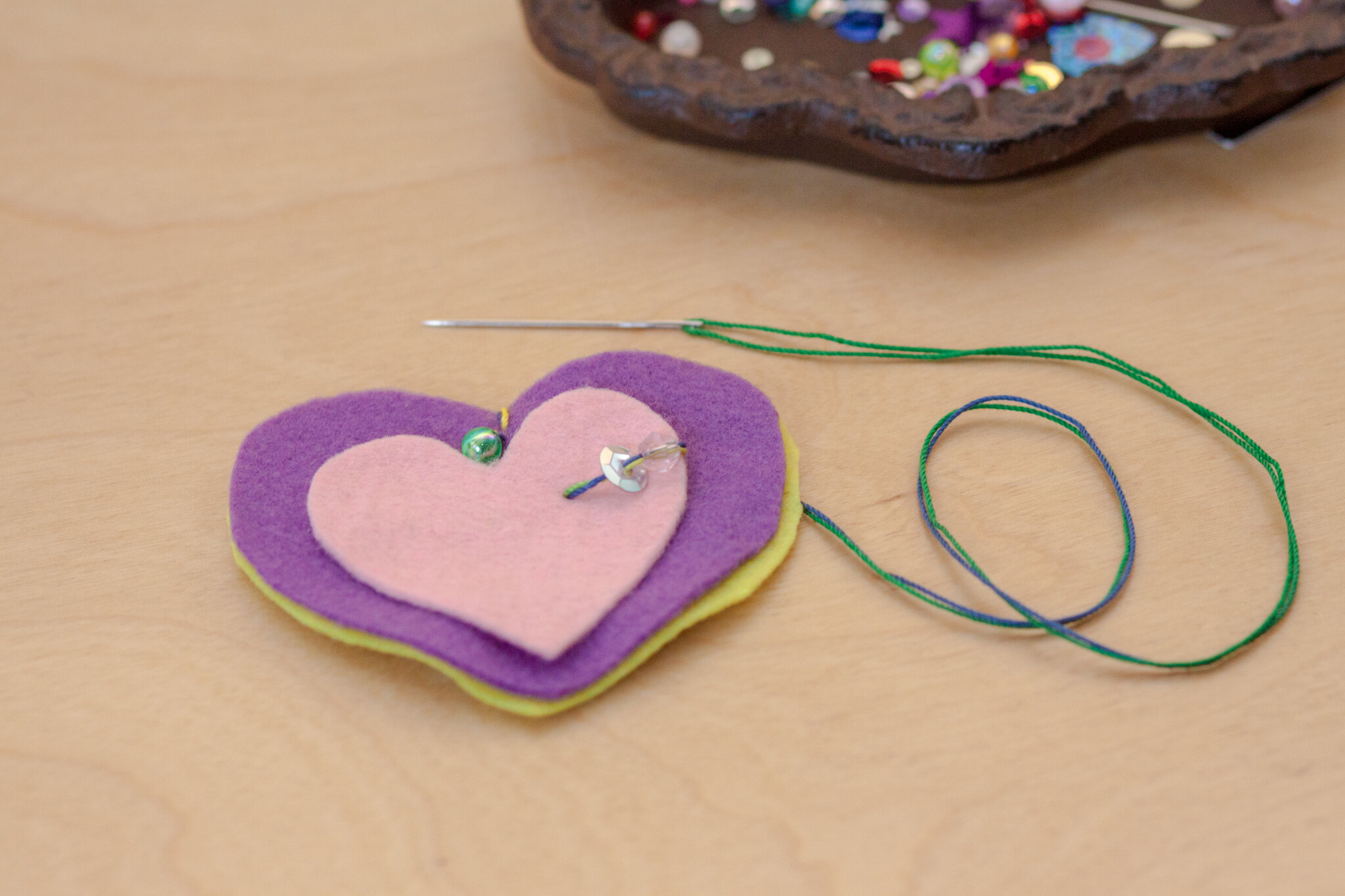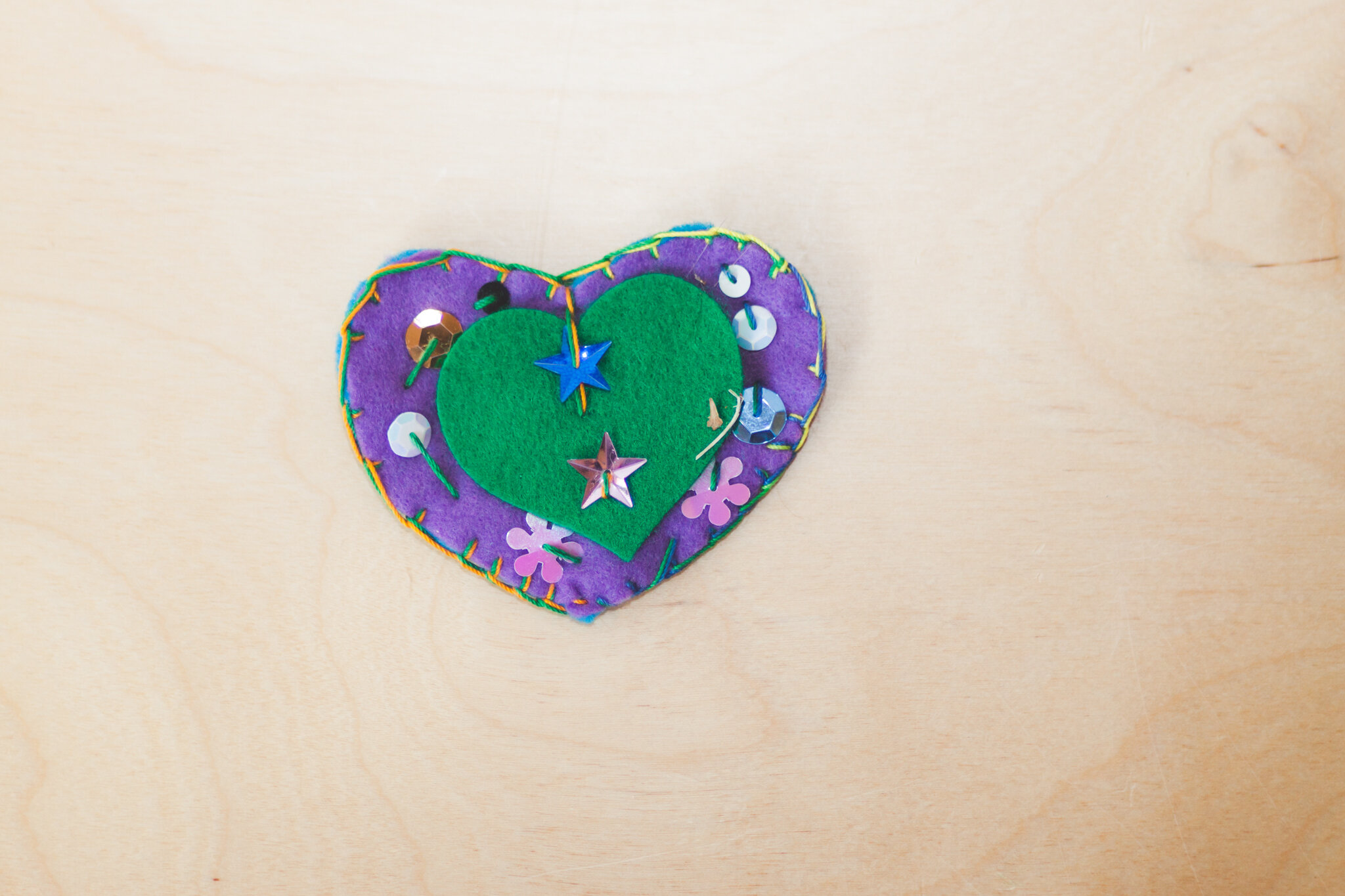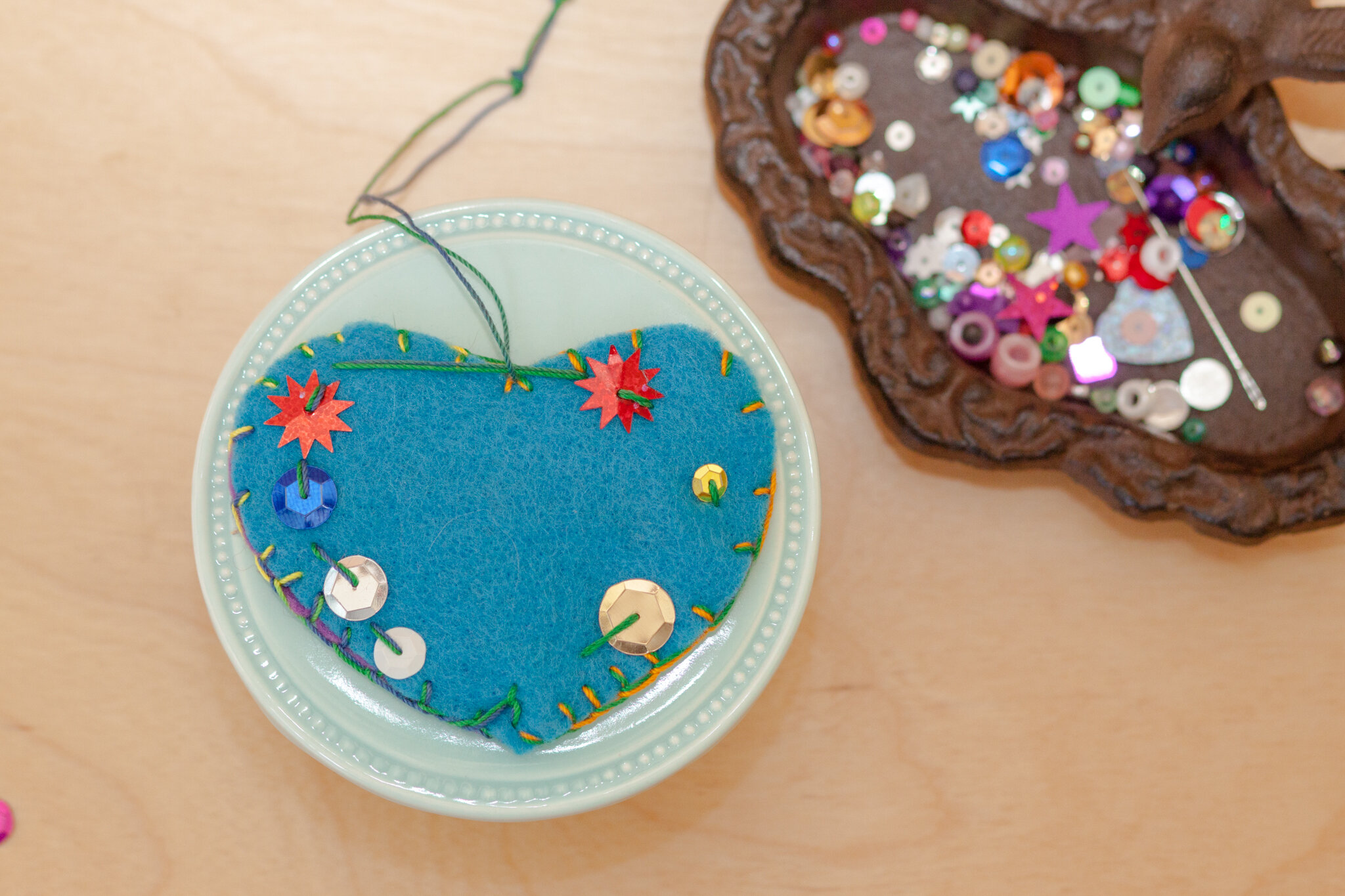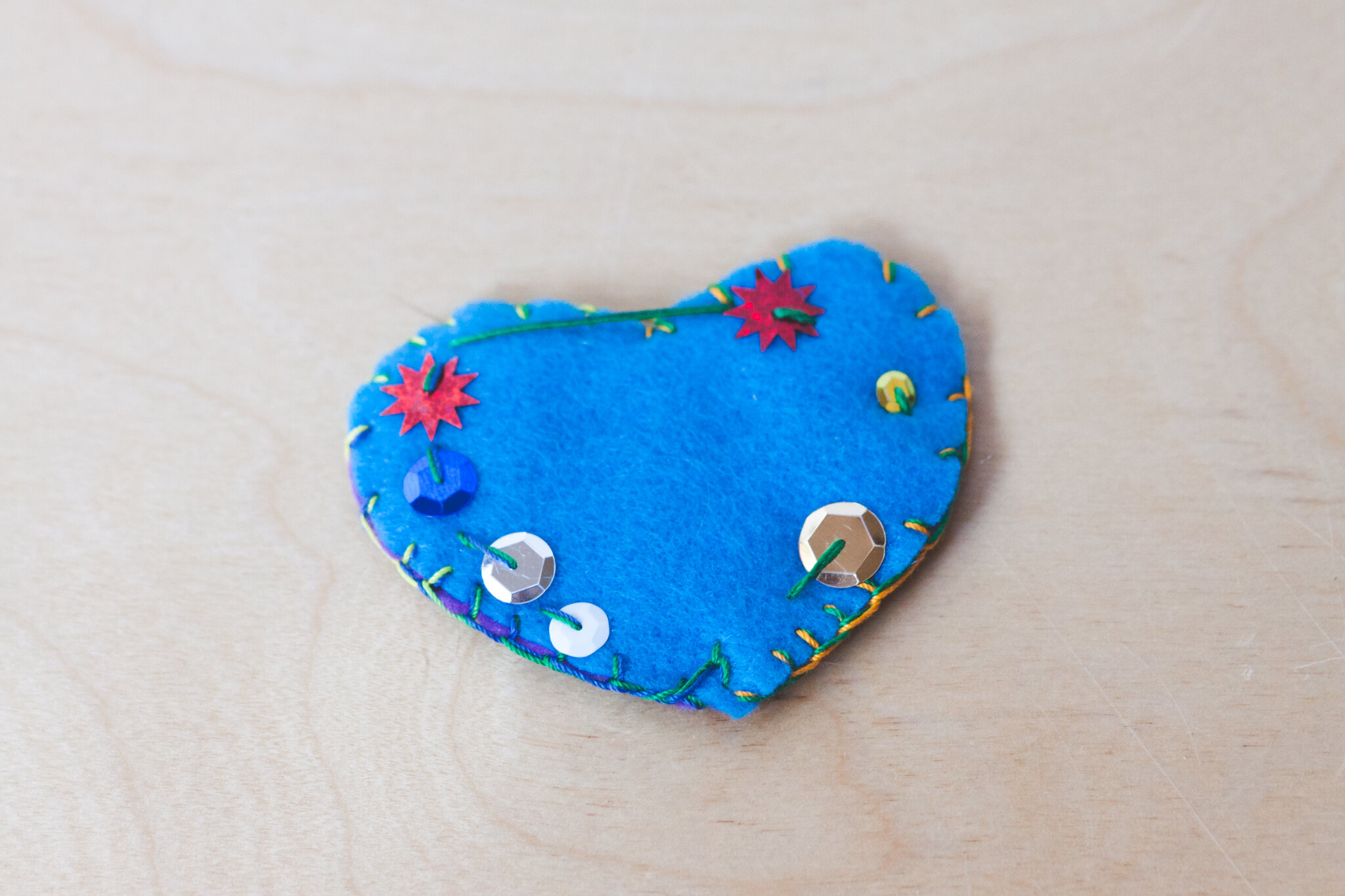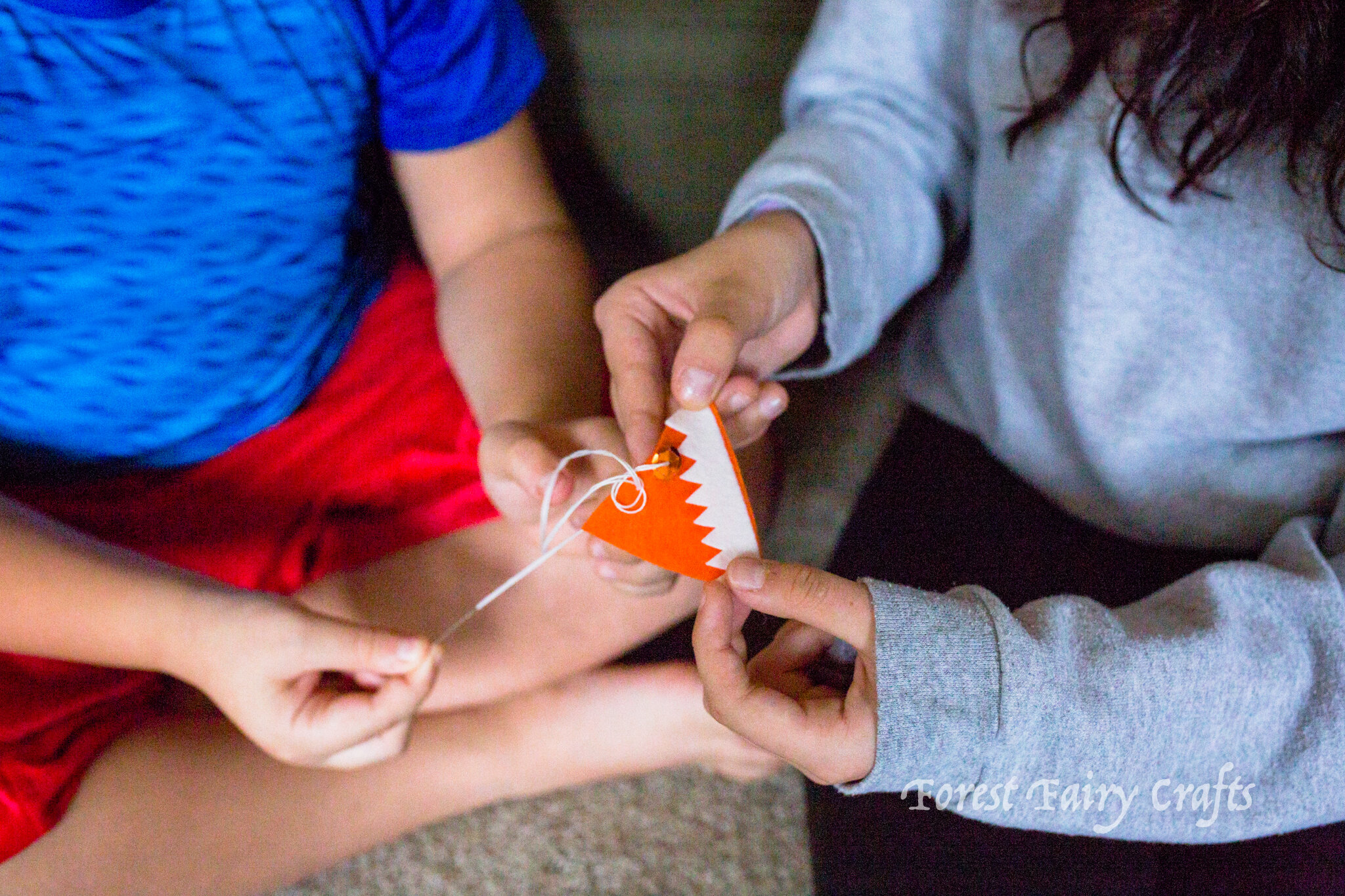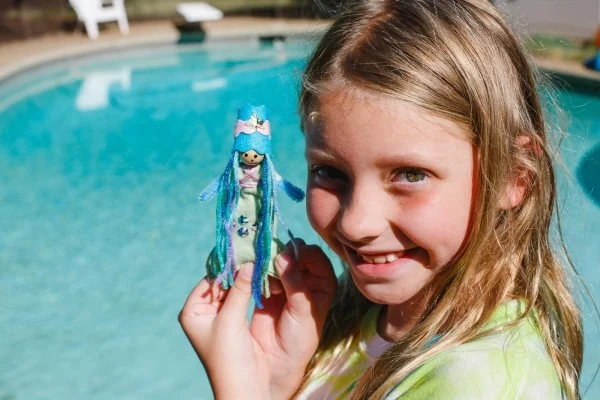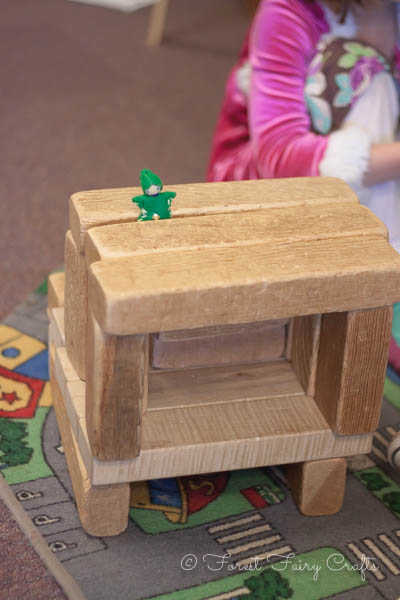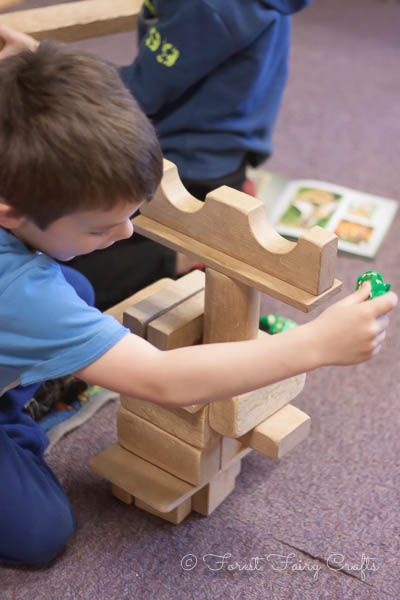
Thankful Book for Fall
In early November, we start our book of gratitudes. Each day we add a page or two or three. We collect the loose pages right before Thanksgiving. And we have a lovely read aloud for our family celebration. In my classroom, the pages became an activity center. At home, we write spend time together creating a child and adult version. Children appreciate hearing about adult gratitudes too.
A guideline that I gave myself was to not give children ideas. Beyond a vague, “family, pets, etc.” Some would go big with “air, earth, water.” Others went more detailed. Eventually, the obvious answers (in their mind) were written down. And then resistance, “I’m out of ideas.” And then the real opportunity- “I’m going to remember grapes to write, they’re so good.” Or, “I’m thankful for goodnight stories.” They took their authorship away from the table to open their mind to ideas away from the table. Which, for me, is the real goal all along. To recognize the many gifts in our day.
Autumn Fairy in Magical Forest Fairy Crafts Through the Seasons
I created book pages that you can download to use with children in your life. *Not for sale or resale. When you download, you’ll notice the book has 4 pages. Why would I do that? This way, each family or child gets to create their own number of pages. Save them as loose leaves until the day before Thanksgiving. That way, an author won’t run out of pages, or face a pile of empty pages on the last night before binding. Customize your book.
For older authors (6 and above), I use the smaller version which fits two pages on one piece of paper. I recommend cutting in half before binding, or you will have blank pages. Since writing instructions don’t often come easy for authors, here is my ladder of support. A conversation with authors that they understand is that the audience matters. Is this for Grandma and Grandpa to admire? Or is it just for the author? Because one way, the spelling may be more important that the other. And the main goal for a young author is to feel proud of their work. Not for us adults to judge or micromanage to the point that writing feels like a chore, but simply for the author to celebrate what they created. You may choose different styles of support based on the audience for the book.
Autumn Gnome in Magical Forest Fairy Crafts Through the Seasons
Also, many supports may be appropriate for different learning challenges. I let my dyslexic daughter dictate while I typed well into high school. She’s in college now and doesn’t ask me to type any of her papers anymore. So give writers the support they need to express their ideas. Which may change from day-to-day.
You can mix and match within the same day/on the same page. They can write until they’re turned and then an adult can finish. Choose a ladder plan, then adjust as needed.
Step 1- writing for the author, letting the author dictate. This is the way to catch all the thoughts and details. This can happen alongside scribbles or attempts at “sounding out” words so that they can be read and understood later.
Step 2- writing and tracing. Use a highlighter or light handwriting that the student can trace with their own pencil. If used, the dictation from above with a step for authors to explore writing it themselves.
Step 3- Write what you hear. This may look incoherent to adults. As long as the child can read it late, then it accomplished the purpose of writing to remember your words later. It doesn’t really accomplish the write-and-share idea, but I can’t read books in other languages, so, for this stage, I let the author reading their own work be enough
Step 4- Write to share. This time, another person needs to be able to understand your words. They don’t seem to be spelled perfectly or have all the right spaces, but another person may want to read them one day. This can be supported with verbal spelling help and room to make spelling mistakes.
Step 5- Write to impress. By this time, sight words should be pretty intuitive. Writing shouldn’t be so much work by this time. Now, spelling corrections and punctuation are involved in the process.
Autumn fairies in Magical Forest Fairy Crafts Through the Seasons
Realistically, think about how long this book will be around. This was created as a process-project meant to help authors notice the world with a spirit of gratitude. Many of these books will go into recycling. You may want to keep them. But then they’ll be a time capsule of where your author’s writing skills were at that point in time. I want young authors to enjoy writing. This project is close to my heart for inspiring young authors.
Feel free to print for personal or small-group use. Print pages 2-3 (large) or 2 (small) for as many middle pages as you may like. Usage rights do not include other teaching sites or third-party websites or sales. I appreciate sharing resources with you.
Add the last page as a bookend, because we are thankful for each and every author.
And of course, Autumn Fairies love to help write these books or hear these books read aloud. They’re always up for an adventure to find more things to appreciate!
We are thankful for you!
Heartfelt Hearts with Children
Invite children to decorate to their heart’s content. This felt sewing project is an opportunity for children to add many decorations. The resulting heart is lovely to hang as decoration or gift to loved ones.
As with all of our projects, be mindful of a child’s abilities and the sharpness of the needle. If you’re using a blunter needle (like a tapestry needle), more layers may be too many layers of felt.
You can also make the heart any size. We recommend not making it a size where the felt becomes floppy and won’t hang straight. You can draw your own pattern on a piece of paper before cutting out of felt. Or we have a heart pattern in Forest Fairy Crafts Through the Seasons.
For any version of the heart, cut out your felt heart shapes. We use crochet thread which doesn’t tangle as easily as embroidery thread. For children, we always put the thread through the eye of the needle, fold in half, then tie slipknot securing both ends together. This prevents the needle from pulling off when they pull the thread taut. The multicolor thread in the photos is due to a variegated thread which changes color on its own.
Use a safety pin to hold the felt hearts together at first. Sew through one piece of felt so the knot will be “sandwiched” between the two felt hearts. Loop around the first stitch so the hearts won’t wiggle (or you can secure with more than one safety pin). Lay a smaller heart on your hearts after a stitch or two.
The direction is to “add decorations, push your needle through, then add decorations.” Repeat and repeat.
These can be strung together to make a garland or mobile. We enjoyed a class collection hanging from the ceiling overhead. They become such expressions of whoever sews them. May your heart’s wish come true!
Reading as a Garden
Before crafts and writing, I was a classroom teacher for over ten years. I taught kindergarten-second grades (along with handwork to third graders). I considered the path to reading one of my most important quests. And, as conversations swirl around reading and children learning to read, I want to serve up a tray of goodies and a cup of tea and chat like I once chatted with parents of children in my class at school. Most schools treat reading as a straightforward path. Follow these skills- learn the alphabet, learn your sounds, and tada, you can read!
Reading is not nearly that straightforward for some children. Especially when I was a “Reading Teacher” and my own daughter struggled with reading. Turns out that she has dyslexia, which was easy to overlook in younger grades because she was bright and engaged and eager to learn. Often, children that don’t meet benchmarks, or goals, by certain ages are called “Reluctant Readers.” They’re not reluctant in my experience. If anything, they want to read so badly. They want to curl up like their peers and wander through stories. They simply, through no fault of their own, haven’t followed the traditional path to reading acquisition (which is a fancy way to say they haven’t “learned to read”).
These are big ideas and big discussions that I’ll keep adding with ideas, insights, and, hopefully, inspirations. Writing Forest Fairy Crafts connects to this idea about creating a world where children are empowered. Not only do children learn to make things, but non-fiction can be an excellent resource and practice for beginning readers. More on that soon.
First, let’s start with a story. Imagine that you need to grow a garden. You’re responsible for a patch of dirt. And you are promised, if you do your work, if you show up, if you dig and plant and care for the soil, you will enjoy the fruits of that labor. Sweet strawberries and blossoms with jewel-tone petals. Leafy shade and lush greenery. The hard work will pay off so many times over.
You can do this. After all, everyone wants to help.
But the soil is full of stones. It’s not easy. Instead, it’s heavy toiling work. The sun is hot and the dirt is hard and maybe your tool is a spoon. Still, you work and work and work because it will be so worth it.
Yet, somehow, every single day, when you return, the rocks are still there. They’re heavy. They’re constant. And just when you think you've made progress, you return to find even more rocks!
You glance over to your friends’ gardens. They must be struggling too. Except they are munching on sweet strawberries. They sprinkle water on growing vines. Their gardens are easy. And they say to you, “We just followed directions. We planted seeds and the seeds grew. Why can’t you do that?”
Then, at some point, the adults get frustrated too. Maybe if digging rocks isn’t enough at school, maybe you should dig more rocks at home. And when you say that your spoon is bent and broken, they say that you can do it because they believe in you. Or maybe you’re lazy. Maybe should practice digging rocks at recess instead of playing with the other children.
By the time a child is called a reluctant reader, they have probably been digging at rocks for years. And, somehow, we think more digging will make reading better. We think that more flashcards, more drills, more time sounding out words will change everything. Sometimes it does. One of the reasons this happens is that some gardens are developmental. Meaning that a student’s garden grows a little later, but it’s part of brain development, so the rocks kinda melt away (usually around 7-9 years old- late enough to cause concern but not long enough to cause lasting skill deficits). Another group is found to have a learning disability that drops tons of rocks into a garden. And targeted lessons can help a student make progress with the rocky soil.
By far, the hardest challenge to overcome is when the rocks become a weight around reading for life. When “practice” becomes a chore. When that “Reluctant” label lasts even after the soil grows strawberries and wildflowers. That label can last long after the rocks are cleared out of the soil.
My goal as a teacher was to hold every student as capable. To recognize the hard work. To realize that reading skills did not equal effort. And to assure children that I was there to help them, to make their garden easier, not to make it all their fault if the soil didn’t grow a garden as easily as their peers.
What can we do, as adults, to help children struggling with reading?
We can recognize the effort. We can say, “You’ve tried so hard, let me read a few pages so you can have a break.”
We can observe without judging. We can see them wildly guess at words that don’t make sense, or sound out every single letter in a word like "s-o-m-e-d-a-y”. We can notice that they do great with books about machines but struggle with stories. We can notice patterns without saying things like, “Why are you like this?” or “Just try,” or “You could do this yesterday.”
We can believe kids. When they say something is hard. Or they have a headache. Or it doesn’t make sense. Believe them. I understand wanting children to work hard, and encouraging them to rise up to challenges. At the same time, there’s incredible relief in hearing, “I believe you.” Believing children can build trust that helps both of you work forward together instead of pushing a “reluctant” learner towards a goal that you both wish they could reach faster. And, trust me in this, they may have very good reasons for struggling. I’ve worked with many children that discovered years after we worked together that they had a processing disorder, learning disability, or additional challenge that meant twice as hard to get half as far as their peers. Struggling was not their fault. Listen to children when they say something is hard.
We can let them read what they like. Who cares if it’s an “easy” book or board book or graphic novel or any other book that doesn’t fit an academic agenda for part of the day? Who cares if they pretend to read a weighty novel to match their peers? You can set aside time for focused practice, and give time for self-selected reading. Let them fly through pages sometimes. Let them have “easy” days where they read the book that you know they have memorized. Let them feel what success feels like. One of the challenges in our learning model is that, once a child masters a skill, we give them a new skill and a new skill. Children do enjoy challenges, and need new quests, but balancing that with comfortable confidence pays off every time.
Let them read wrong. When we call attention to every mistake, that can make children hypervigilant for mistakes. If the error doesn’t change the story, let mixed up words slide. Especially if they can tell you what the story was about at the end.
Let them know when they’re reading well. We can focus on mistakes and miss the ten words that were read fine. At the end of a page, for short texts, notice that they read “the, cat, went, to, the,” wonderfully. Reflect places of strength alongside where they needed help.
Let them read more than books. Let them read food boxes and brochures. Let them read non-fiction. Let them read recipes. Let them read directions about how to put favorite toys together. Let them read rules for games. Let them read until they’re tired and then help out with reading with them (or for them).
My hope is to collect more stories and ideas in the coming months. As a parent, I relied on other teachers to help me understand how to help my daughter. But with all sorts of questions about school during Covid, I want to share my insights with parents and students that may not have the usual school resources.
My main quest for young studetns was to nurture an interent and fascination with stories and non-fiction. Skills can come in time. We can help them dig rocks. But if they learn that gardening is awful work, that attitude lasts long after they can successfully grow (or read).
One of our goals with Forest Fairy Crafts was to create books that could inspire meaningful reading for children. I look forward to sharing how we hold that vision, and how that can inspire children of all skills and abilities, in the coming weeks. We can create magic. Because reading, like growing sweet strawberries, is one of the best magics in the world.
What is Handwork
When we first told children about handwork class, they may have been confused or even concerned. “Work? Why?” they might say. And, after a few times of seeing it on the schedule, they eagerly looked forward to handwork. And part of that was demystifying the question of what is handwork?
And we could unpack why “work” elicits a “noooo” in itself, but that’s another discussion. Instead, I want to share what Handwork means so as you search for activities and projects online, you have another search term to help you discover more ideas.
Handwork, simply, is work with your hands. And by “work,” is simply means “making things with your hands.” Handwork could be sewing or beading or knitting or weaving. In theory, it could also be whittling or sculpture or making machines. In the context of handwork in early childhood, handwork usually refers to making things by hand with fabrics, thread, and/or yarn. It tends to be soft materials. But the principles could be applied to other mediums as well.
A few simple, maybe obvious things, is that handwork uses the hands, preferably both hands. This is different from the usual schoolwork that usually emphasizes skills with a writing or drawing hand. In handwork, one hand holds a needle while the other holds material (eventually, for young-young children we hold the material for them, precisely because it’s hard for their brains to regulate two hands doing two different things). I’ll write another post about how two-handed activities build brain connections soon. In an easy sense, handwork encourages body awareness.
Handwork is a creative activity that encourages children to create and make things. The things you make can be fun like toys or decorations. And they can be useful like pencil bags or pouches. Handwork empowers children to see real-world results from their efforts. And the results may not be as tidy as a store-bought equivalent, especially at first, but that shouldn’t matter. To bring something into the world that can be played with or gifted is so empowering for everyone.
Handwork can also be an activity that isn’t meant to last forever. It can be lacing cards or beading that is unstrung after reaching the end of the thread. It doesn’t have to be a keepsake every time.
And eventually handwork moves from a high-concentration, active-thinking activity into an intuitive, calming activity that is perfect for background engagement. We always let students finger-knit during storytime. Some students listen much better when their hands are occupied.
The internet shares an abundance of ideas for handwork. Of course we collect many on our Pinterest Board called Handwork for Children. If you’re new to the idea of handwork, most children love creating friendship bracelets. You can make braided or beaded bracelets with only a few supplies.
Something that I don’t often see discussed in “What is Handwork?” is the context of how handwork helps all of us develop persistence and resilience. Handwork helps children encounter frustrations such as a tangled thread or not understanding how a knot could possibly ever knot. Handwork encourages working through challenges in a way that genuinely shows progress.
If you start with a search for Handwork, you’ll find a lot of information to inspire you to start activities. And then you can narrow the idea to what inspires children in your world. Maybe weaving or knitting or embroidery. We would often start with finger-knitting, with one strand (shown in the first book). Then, as children mastered that, we would sew a simple something. And then we would combine mixing and matching so children saw different ways to use what they created. And early easy project was a bookmark (and friendship bracelets). One way that I like to find activities (besides looking in our books of course wink, wink) is to tap on an activity on Pinterest, then scroll through related pins to find similar projects.
And my last thing about Handwork was that, in our handwork, we gave students a lot of room to bring their own “voice” to a project. Three sequins or thirty sequins or all blue sequins would create projects that reflect the maker (or handworker?). We did say that that a student did need to invest a set amount of time before saying, “done,” which was important especially when they were first learning, because they might need to keep at practicing before it became more comfortable. Another strategy for reluctance was that they didn’t have to sew, but they couldn’t do anything else either. They needed to sit with their project whether they worked on it or not. After a few minutes of sitting and staring at their project, students would sigh and pick it up to sew more. We rarely needed to lean into the “time investment,” though. Usually, we had to encourage students to stop, haha.
How do you define handwork in your home or classroom? We sure found that once children learned what handwork meant, they asked for it daily, which also meant that they began to change their ideas about “work”. Which may be a great life lesson as well. Speaking of, it’s not only children that enjoy handwork. We can all use a little handwork in our daily schedule :)
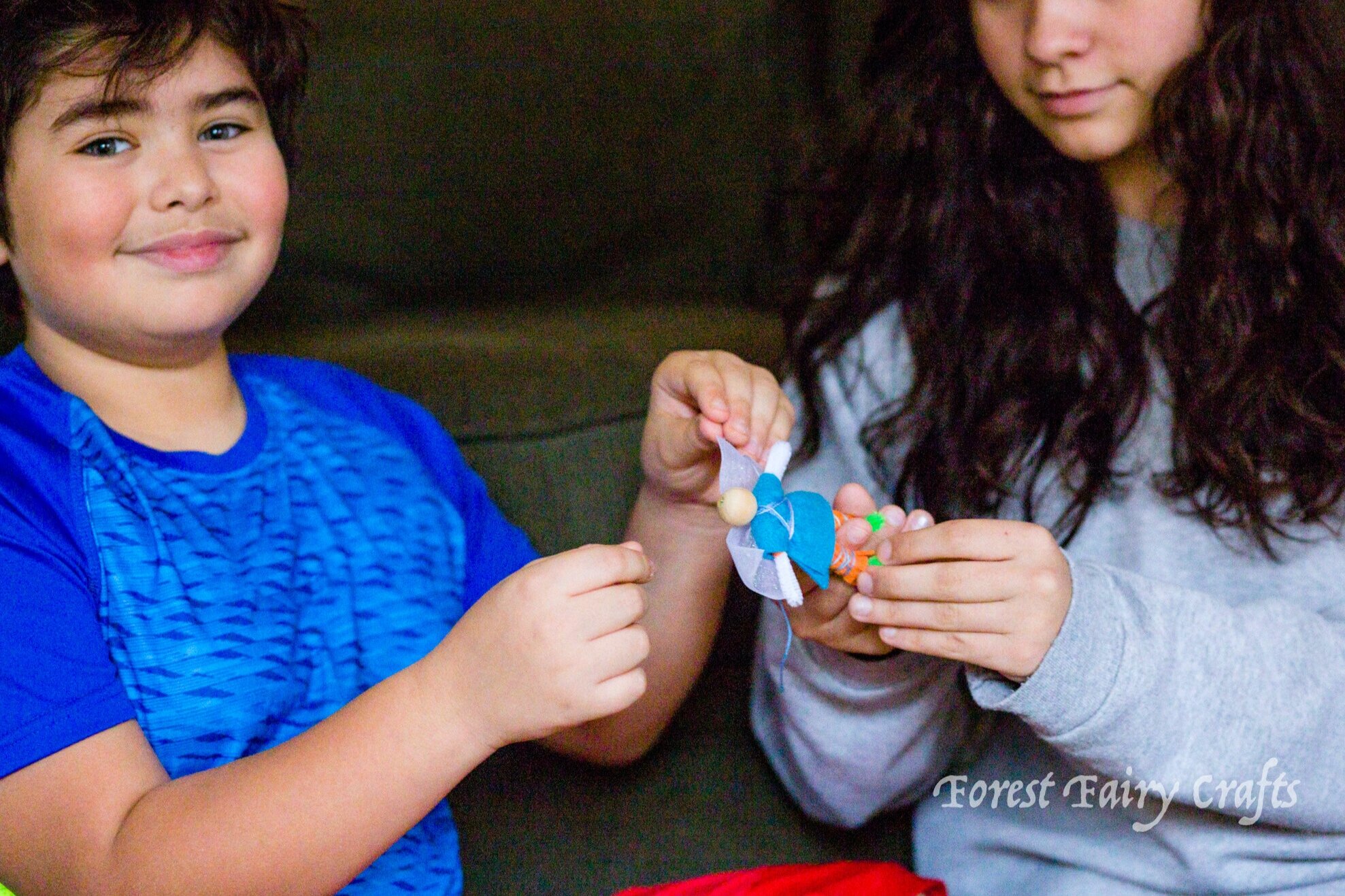
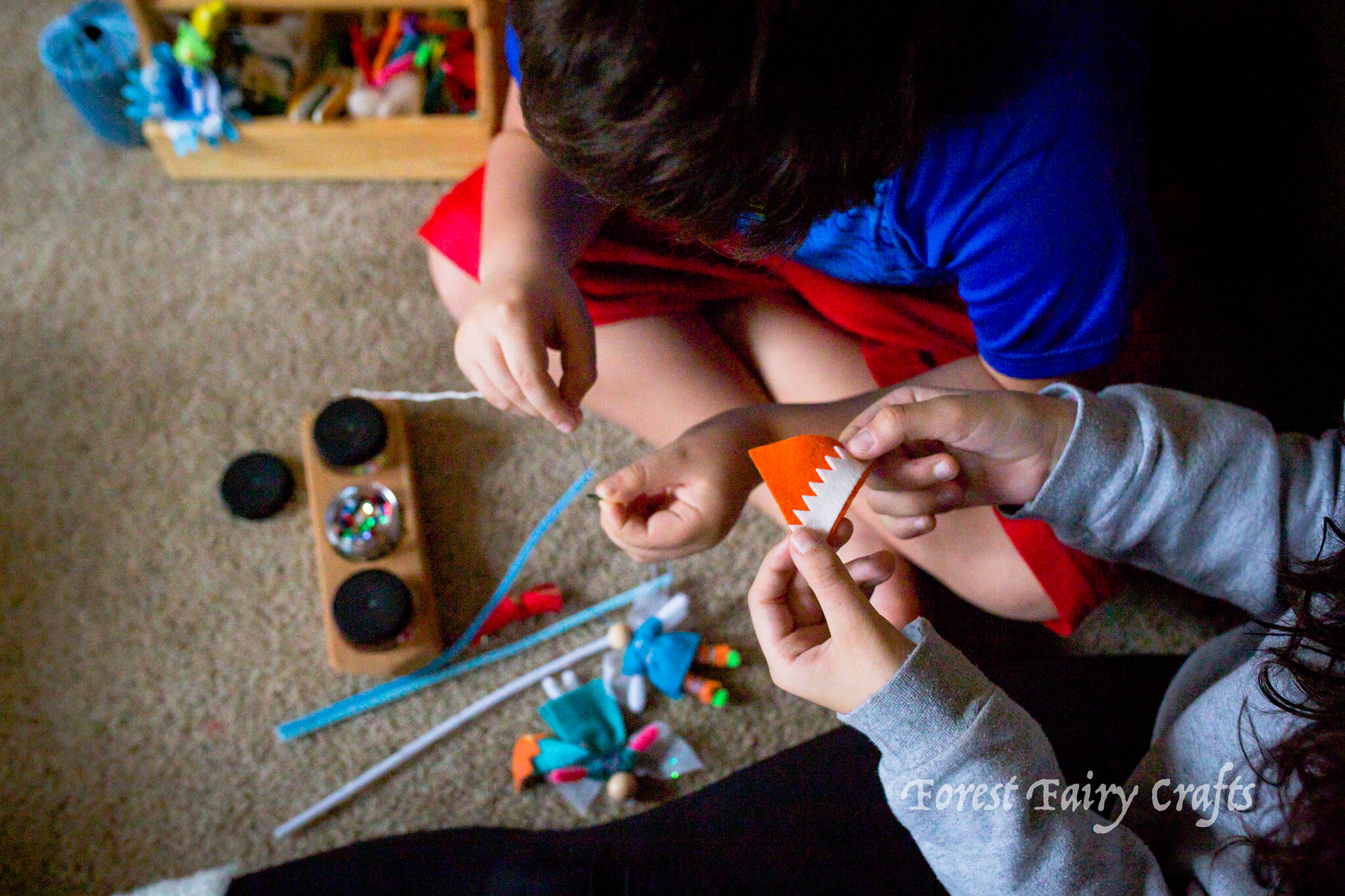
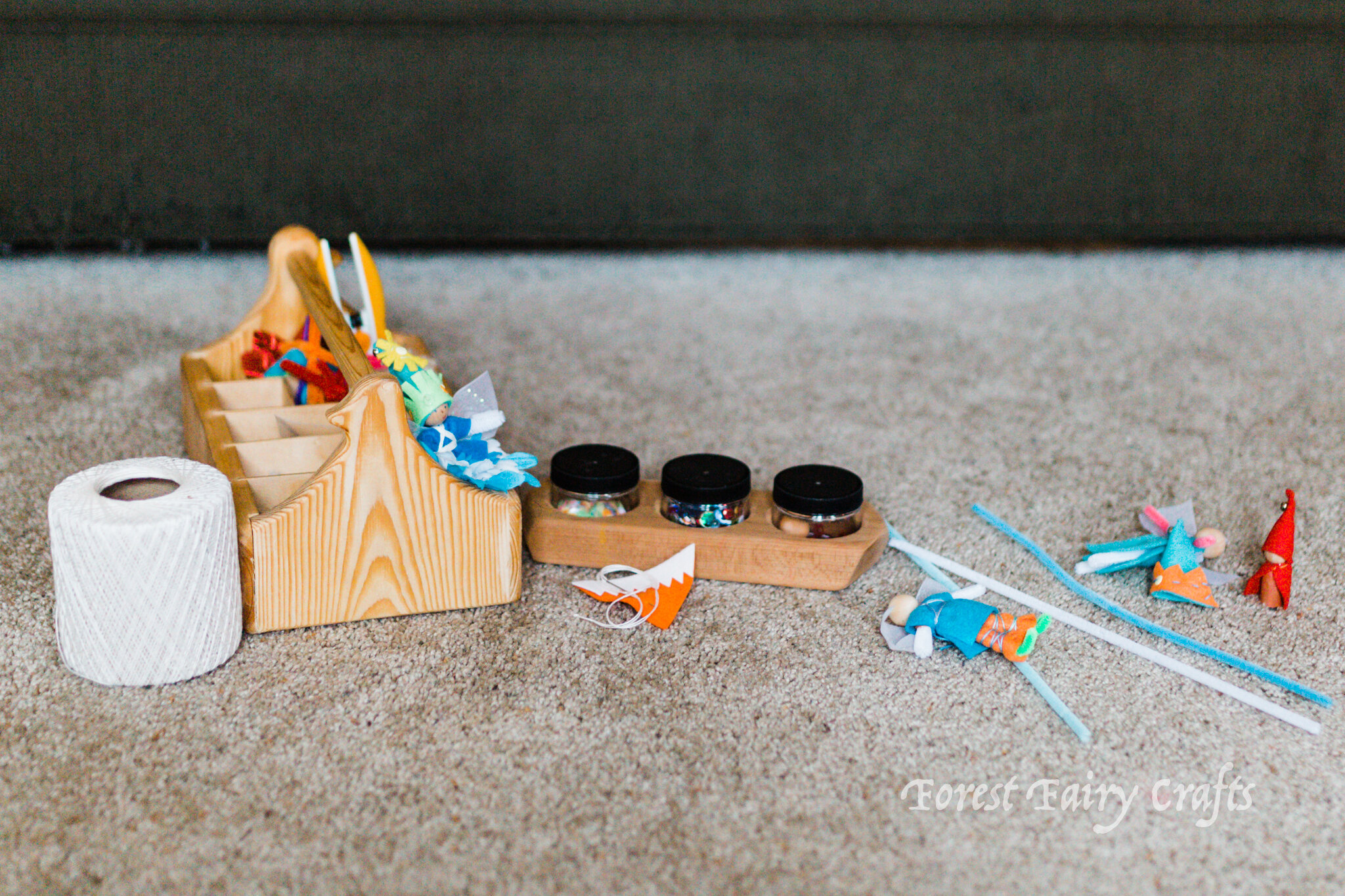
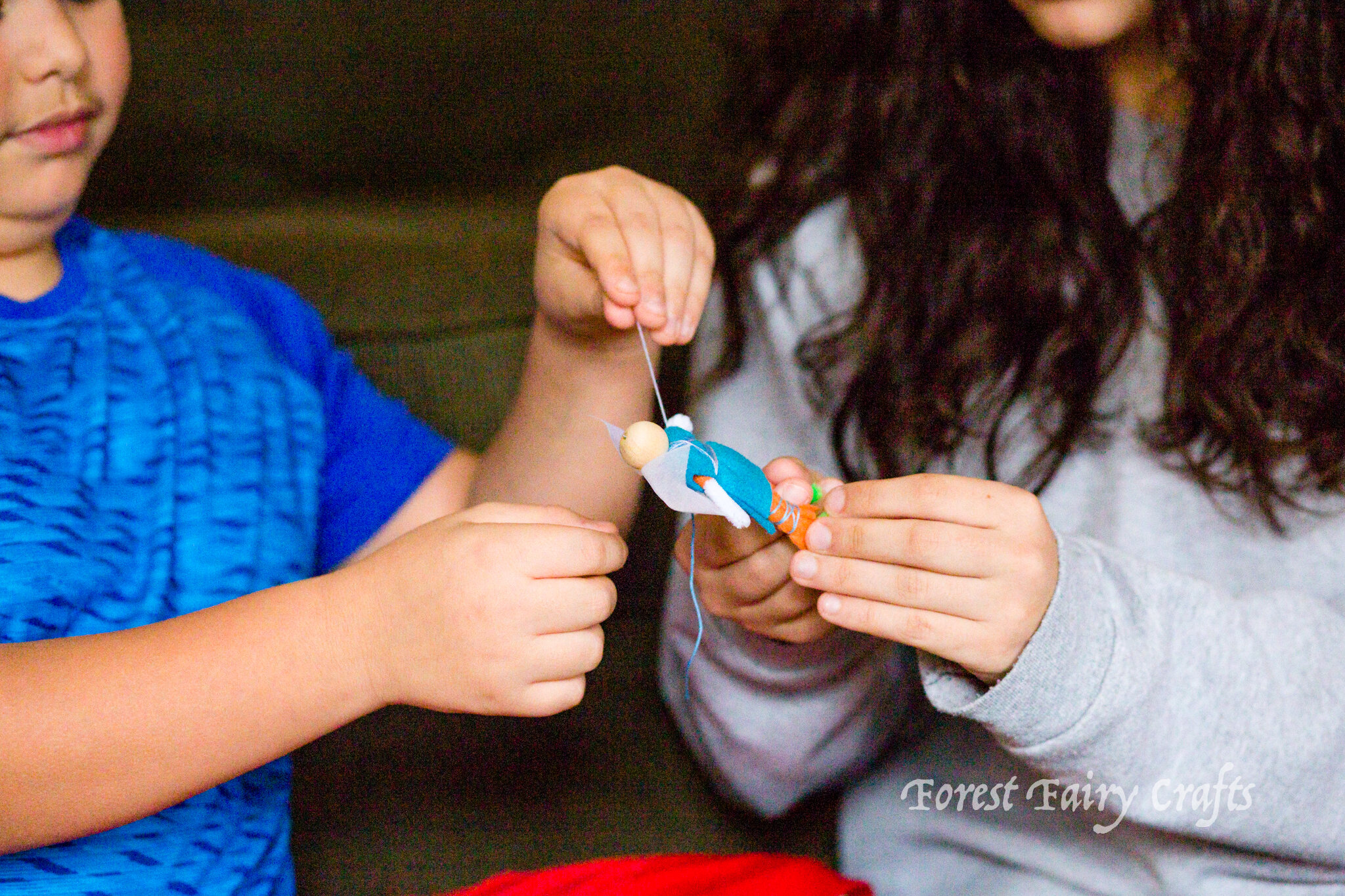
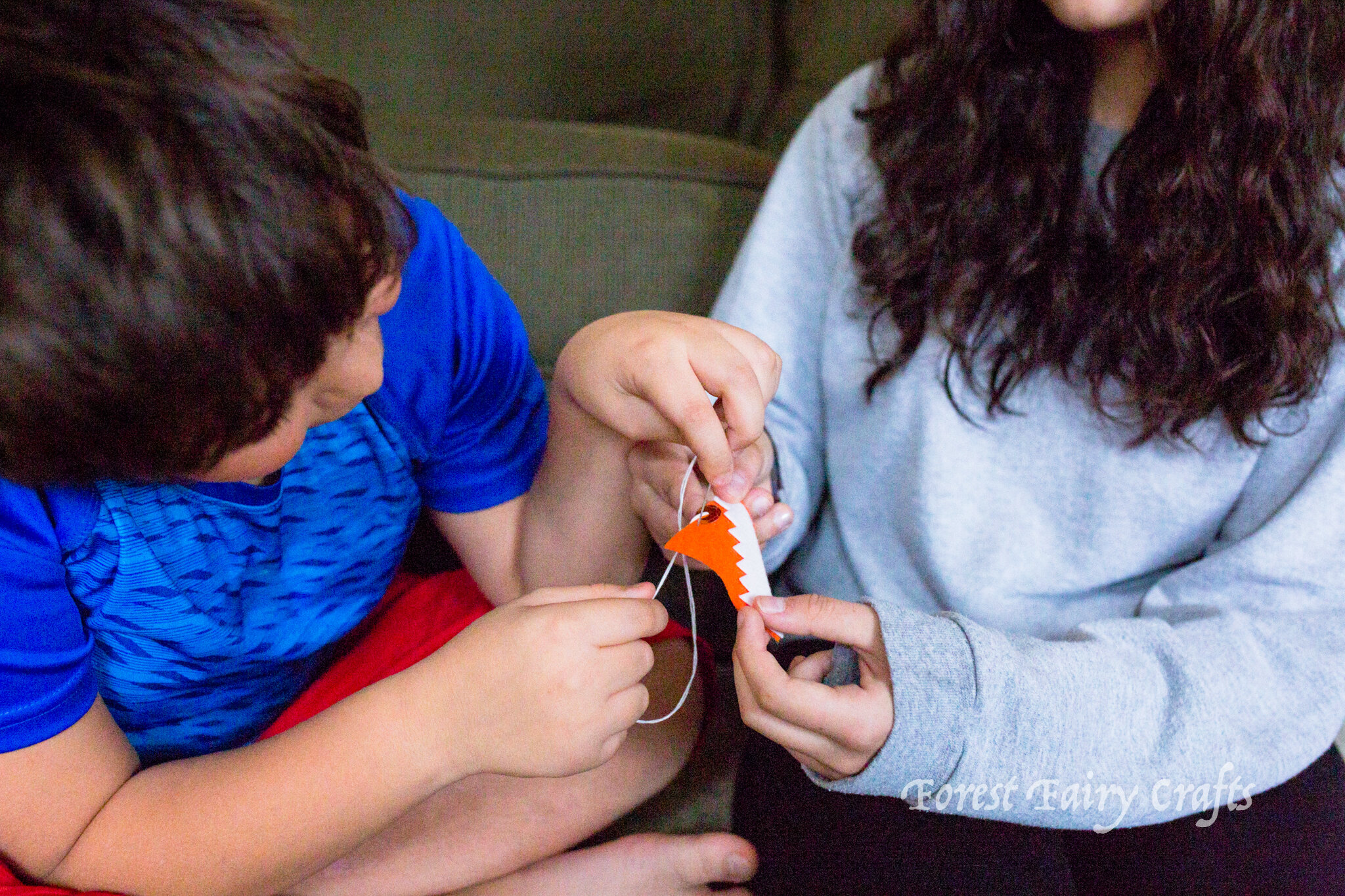
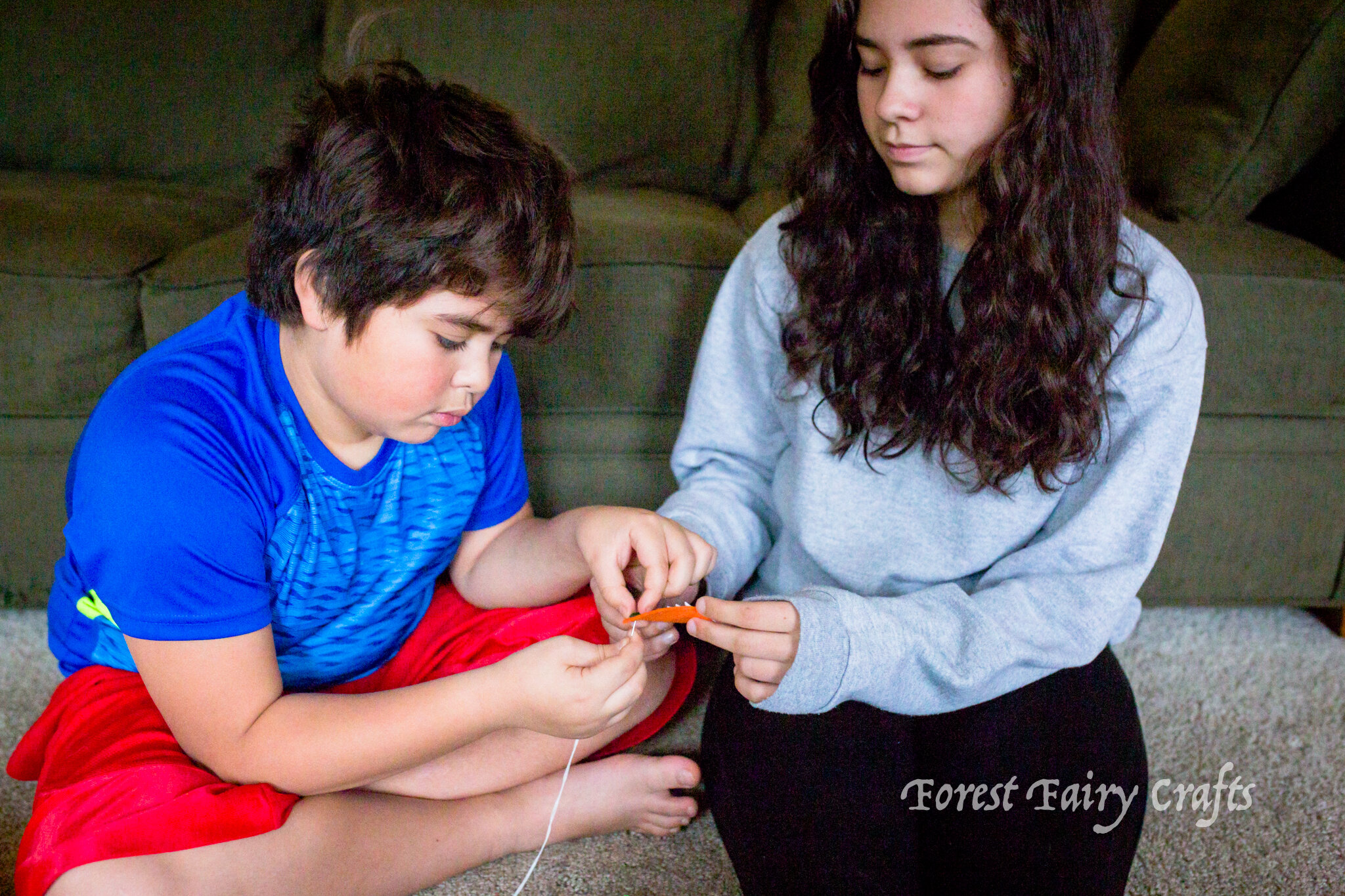
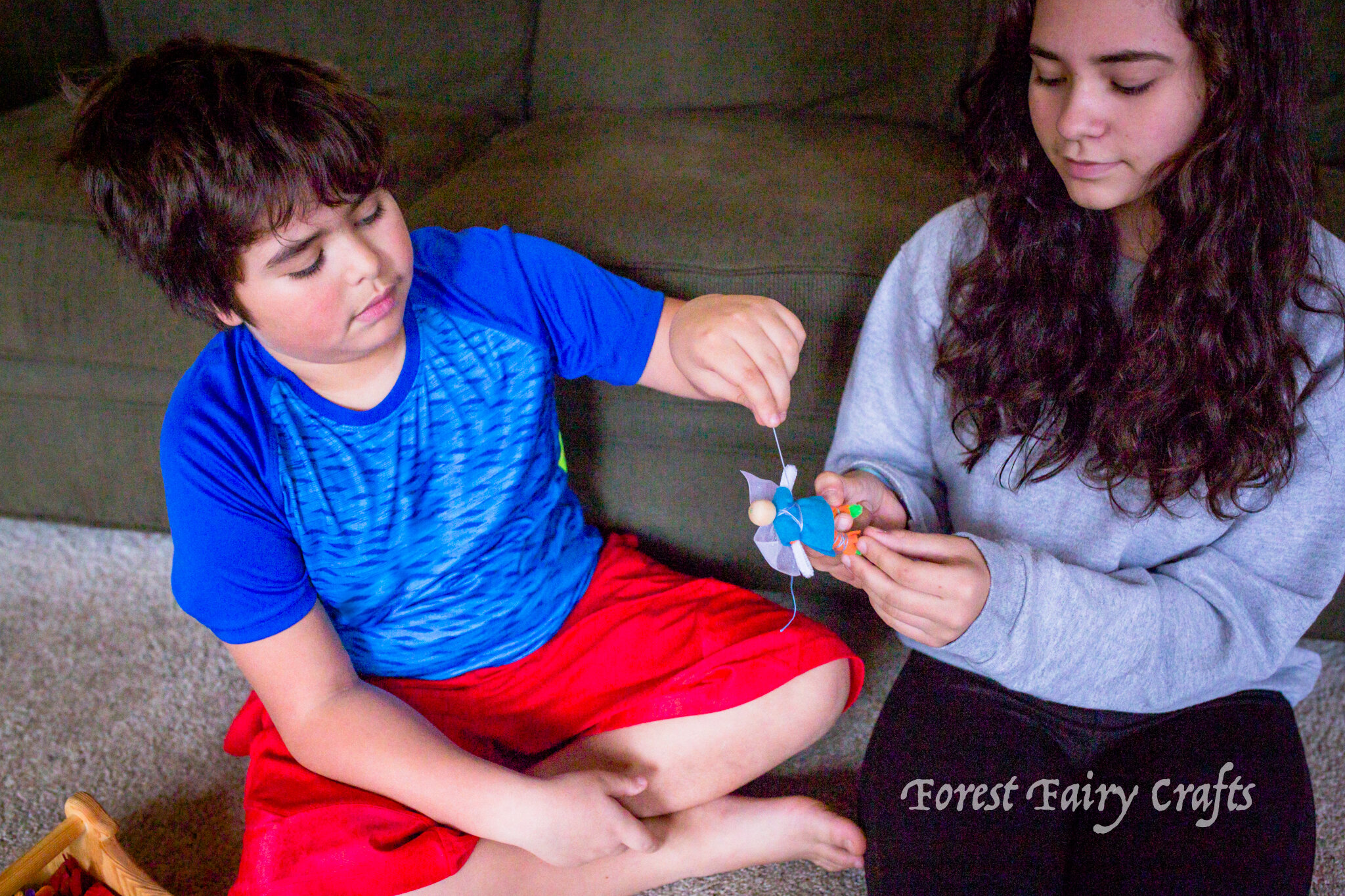
Art Inspiration with Color
This week we are juggling middle school distance learning with * waves towards everything else *. And we are so fortunate to have the ability to stay at home. I manage to work from home, though productivity is extremely challenging. This project was simple and engaging. I approached it as a science, open-ended process art project. And he actually loved the results. So win-win!
Prep:
Using a sharpie, I wrote the main color- his favorite color- at the top of the page. He could have written it himself but I wanted to make it an “easy onramp” because the resistance to “work” is real (and exhausting). To be honest, I get it because I feel that undertow too. I know that engaging in activities is rewarding, though, so I made this as easy as possible to start. Anyway, I drew circles across the page. Imperfect circles with different sizes (easier for me) with a sharpie. It has to be a pen that doesn’t react to water because that will mix with the paint.
Painting:
I set it up with him with the question- how do colors interact with orange? Mix them on your brush or on your paper. What causes different shades of orange?
We also talked about water tension and that if he didn’t have water go outside the circle, the paint would stay in the circle as well. Then we ended up going outside the lines a bit too.
He really enjoyed creating different shades of orange. And we got to continue the conversation when the page dried and colors changed slightly.
What we learned:
The paper influences the mixing a lot. We used a sketching paper that soaked the water quickly so it didn’t work to mix in the circle as well. We ended up mixing more directly dipping the brush from one to another color. Once he mixed two, I suggested three. We also mixed on the lid of the paint tray. Our paints, by the way, are Lyra watercolors available on A Child’s Dream Come True.
It would be fun to try with watercolor paper where you could drop one color onto the other on the page and see them interact.
This is a fantastic project for scientific “what if” questions. There really isn’t a wrong lesson for children to learn. I ended up painting beside him because it was fun to try different combinations.
Oh, and it may be surprising to see how some colors “play well together”. If you group warm colors together, and cool colors, similar colors (warm-warm or cool-cool) will enhance the chosen color. This can also be called analogous colors on a color wheel. But adding the opposite, like adding blue to orange, makes the orange look gray-green. Why? It connects to the idea of complementary colors that react differently with the chosen color. You can learn more about colors by researching.
We strongly encourage children’s curiosity, especially if they ask, “Why?” That gives you an opportunity to go learn more. The first step is observing, which means letting children try things and ask their own questions. Art is a wonderful way to explore ideas.
Of course, you can use different shapes, too. Squares, rectangles, triangles… lots of creative potential. We hope you have fun experimenting with color 🧡
Summer Mermaid
Ah, summer. Your long days that go so quickly! With kids home from school and temps soaring, we spend more time in the water than on land :)
Summer is for mermaids.
We are slightly obsessed with Fin Fun Mermaid Tails over here :) as anyone who follows my Instagram knows well. My daughter and niece adore becoming mermaids.
The next best thing to being a little mermaid is making a little mermaid. I am super-lucky that my niece spends a few days a week with us in the summertime. We play outisde, go to the river, and craft together. We call it Camp Lenkaland :)
My daughter needed Forest Fairies for an entry in the county fair (more on that later). While my daughter sewed her fairies, my niece made a mermaid.
So sweet :). These mermaids aren't for swimming in real water, of course, but she's already joined my niece's collection of Very Special Things. We can create magic :)
Yes, summer is fleeting. Yet the memories last forever :)
Magic Wands with Yarn
So simple and so fun for the class today. I collected fallen branches about a foot in length. I brought sandpaper, yarn, and a few beads to class. Students chose the branch that "spoke" to them. They could use sandpaper to smooth rough patches. A few spent ages making their sticks all smooth.
I showed them how to tie a knot around the branch- the short end dives through the loop, wrapping around the long end. I showed them how to hide the short tail by wrapping around it. We discussed layering colors and adding beads. I said they could fingerknit then wrap the knitted chain. They wanted to engage quickly so no one tried that. Another day :)
Their wands went home with them today, all unique and beautiful! Just like the children :)
Making Peg Dolls and More in the Forest
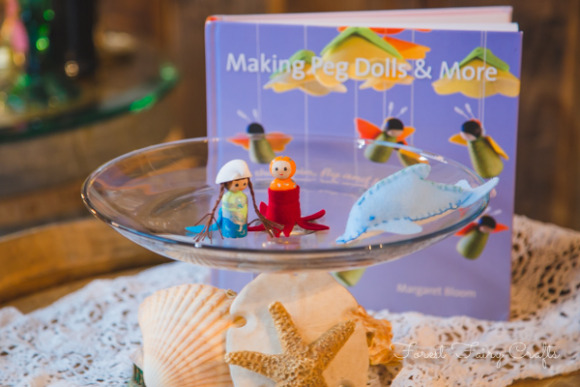
We love peg dolls in the forest. We love being inspired.
Margaret Bloom sure knows how to inspire us! Her first book, Making Peg Dolls, showed us how to create lovely little pegs for our collection. Her new book, Making Peg Dolls and More, shares new fantastic ideas! We couldn't wait to dive into the pages.
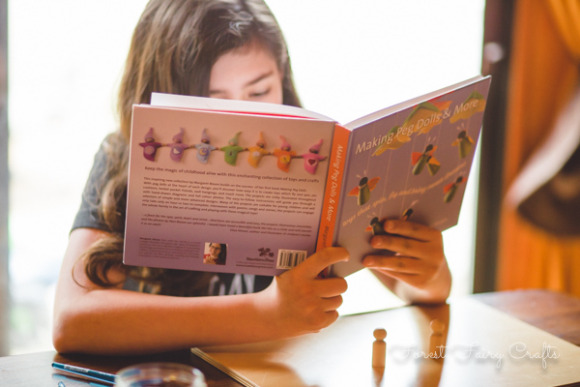
My daughter is a mermaid :)
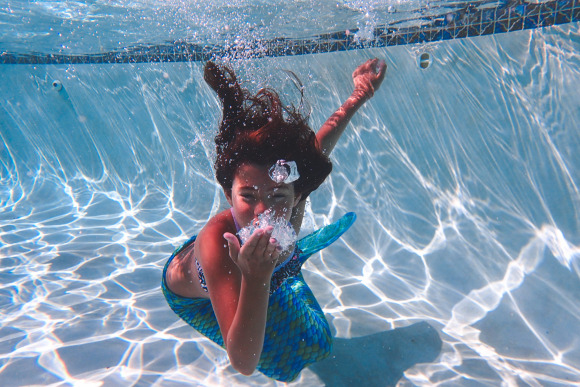
So of course she chose the mermaid project. My son is all into ocean creatures these days. The octopus was just perfect! To complete our ocean adventures, we sewed the dolphin too. I haven't made many felt animals so I was a little nervous. The directions worked fantastic!
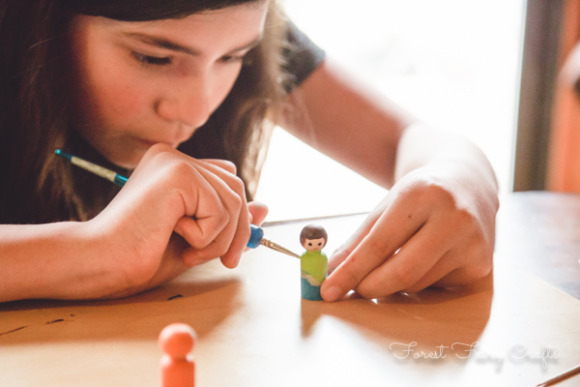

The painted pegs were so cute just by themselves! Even cuter with the felt pieces :)

We love how each step of the craft is shown with easy-to-follow illustrations and beautiful photographs. As a mom, I enjoy invitations to create your own vision. My son loves, loves, loves orange. So we made an orange octopus for him.
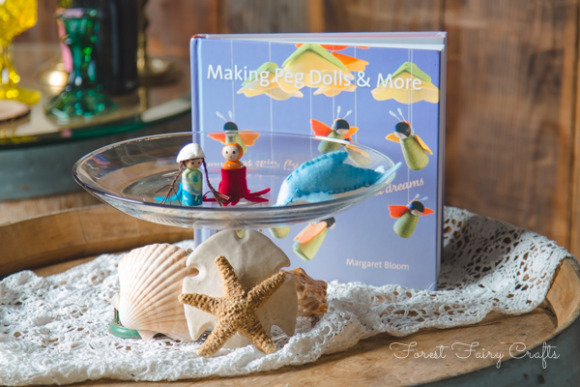
My daughter decided that her mermaid needed a seashell for a hat. Is that okay, Mom? Of course! The beauty of creating is that you get to make your visions. Take inspiration and grow. Learn. Discover.
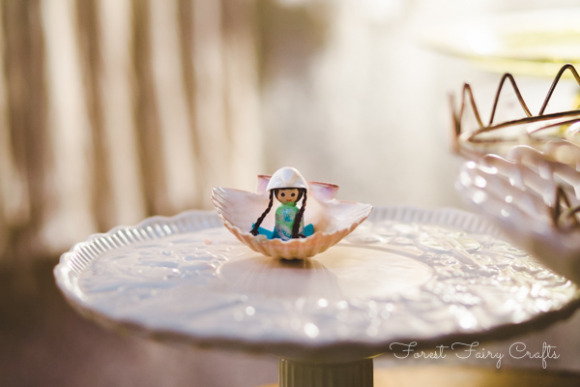
Find magic.
Be delighted :)
The fun is just beginning for the little ocean pegs. They are already finding adventures.
Joining Margaret's Bloom celebration for her new book delighted us! We know that lots of wonderful things are going to made from this book. Our fun is just beginning :) Our mermaid, octopus, and dolphin need more friends.
As a gift for all of us, A Child's Dream Come True (which carries our favorite felt) has gifts for anyone ordering Making Peg People and More. This week (until February 14, 2015) you receive a special free mini-bundle of wool felt and 2 Large Wood Peg Dolls! You can also enjoy 10% off Holland Wool Felt Yards + Cuts and 10% off Wood Peg Dolls. Simply enter code: DOLLCRAFTS in your shopping cart to apply and see the discount. They also carry Forest Fairy Crafts :)
Follow the Entire Peg Doll Blog Tour!
Enjoy!
Acorn Gnomes
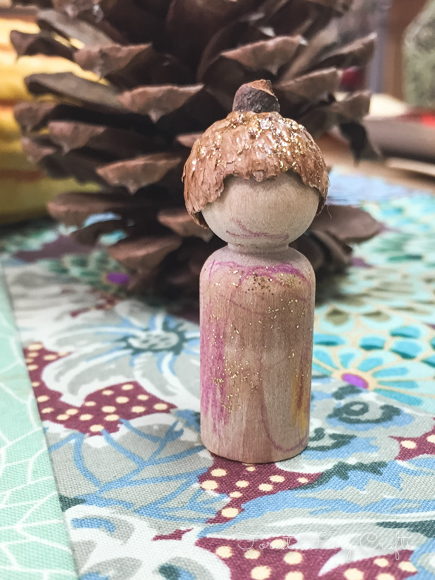
About an hour before class with my youngest kindergarten students, I was inspired. They had a feast later in the day. They would be excited, yet needing to keep busy. They needed an activitiy that would be fun, successful, and simple. Enter the Acorn Gnome.
Easily the easiest gnome ever. And, yes, that's two 'easies' in one sentence :). For this gnome, I gave each student a gnome and colored pencils. We talked about gratitude, and guests at the table, and whether gnomes are real (very heated discussion there). Then they decorate their gnome. They chose their acorn cap. I added glue. Let the gnomes dry a bit. Then I dusted them with a thin coat of gold-glitter paint. Just because everyone loves a little sparkle.

One student opted out of the acorn hat. He didn't want to hide his art under an acorn. Another made Darth Vader. We discussed using our imagination for faces (not needing to draw a face).
The gnomes became guests at their feast. Super sweet.
Oh, I did bring a little sharpie to write initials on the bottom of gnomes. I changed it quickly to teeny-tiny names because intials were a strange idea (these adults with their strange ideas!).
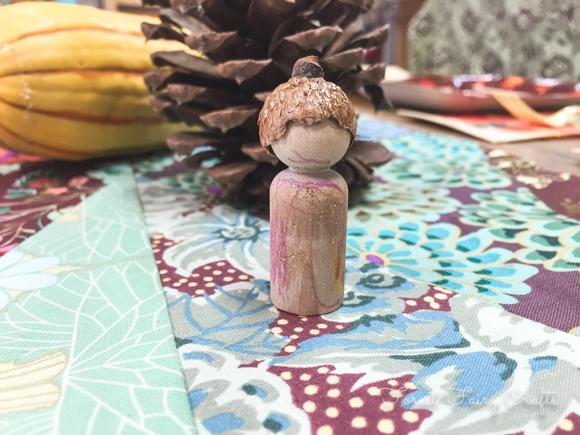
Supplies
- Peg dolls
- Acorns (would be fun to collect with children, but I didn't have the time, I always collect them when I find them (again, adults and their strange ideas)
- Colored pencils
- Craft Glue
- Sharpie for names
- Optional glittler paint
Create
Write names when handing out gnomes. Children decorate pegs however they like. Call up children to choose an acorn. Glue acorn caps. Allow to dry during recess. Paint light layer of glitter. Let children enjoy and bring home!

Big thanks to Teacher Holly at the Nevada City School of the Arts for making this class possible :)

Wishing everyone a very happy day. Hoping these gnomes find you with family and plenty to be thankful for!
"Leaf" Gratitude
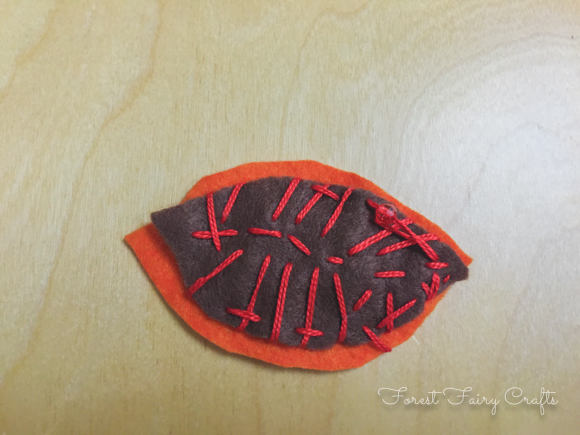
A student named this project. I wanted a way to treasure all the amazing things in our world. We were inspired by the many leaves turning colors and falling this time of year. What if we could sew a leaf where students could collect gratitude inside on slips of paper?
The leaf can become a decoration with a surprise. Students decided they might add gratitudes before Thanksgiving to share on the day. Or they might go around on Thanksgiving and ask everyone to add a gratitude on a little piece of paper to keep inside the leaf. Either way, they discovered these are the perfect way to 'Leaf' a gratitude!
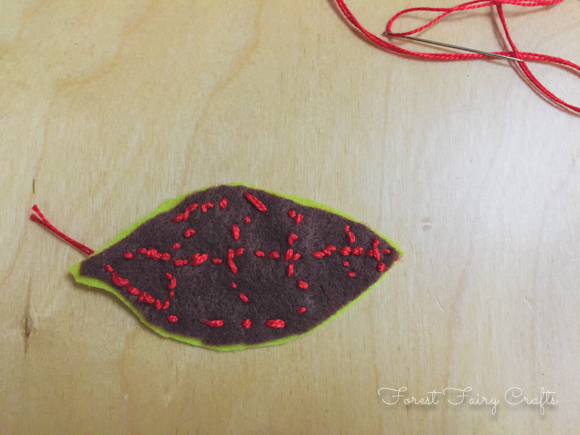
Supplies:
- Two colors of felt
- Scissors, needle, and thread
- Decorations (beads and sequins)
I cut paper with this second/third grade class a lot. I hoped we could make the leap into felt (saving me a ton of prep time). So I brought in rectangles of brown felt. We talked about shapes of leaves and "cutting out" triangles or curves to create a leaf. Students often want to "cut around", twisting the felt and cutting things in half accidentally. We had mixed success. A few needed a second piece of felt, or the leaf was super-small, or not what they expected. We worked through the hiccups.
We talked about decorating one side of the felt. I did show them how to stitch so they could to embroider the veins of the leaves if they wanted. They all looked beautiful in their own way. Students chose the color for the back of the leaf.
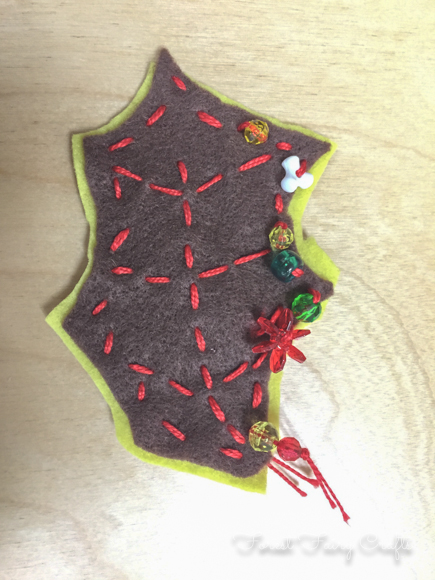
At home, I cut the chosen felt bigger than the leaf. I made it roughly similar, but did not meticulously cut the felt to match. This way, if it wiggled, they had room to keep sewing.
For the next class, we talked about sewing up and down (running stitch) and traveling around the edge of the brown leaf like a little caterpillar. "Leave a gap," I said, "So your leaf has a secret compartment for gratitudes." They could add beads and sequins as they travelled around. Each leaf became lovely. We tied loose ends and children promptly planned how they would surprise their family with gratutides in the pocket. A few plan to add it to the Thanksgiving table. A few want to add a loop to hang their leaf. Lots of ideas.
Which is my favorite kind of project. A craft that inspires!
You can see the little gap on this leaf- a space without stiching so you can get inside the leaf.
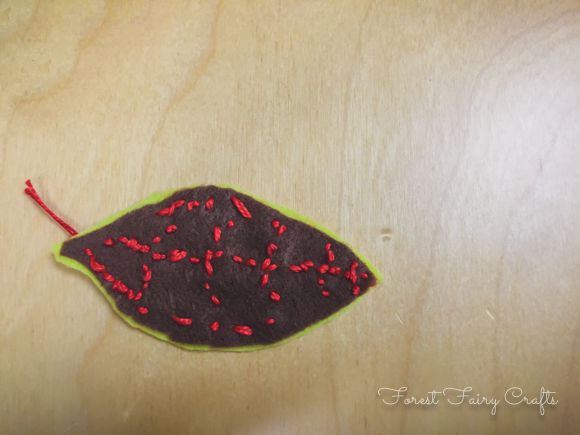
Hurrah! Wishing you and yours a very thankful season :)

Batty in the Forest
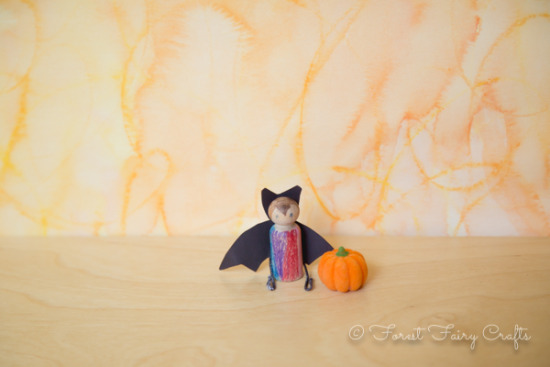
We adore bats!
The bats on We Bloom Here inspired us! We had to bring them to Handwork class. But how? Each week I am challenged to bring an adorable and sweet idea to forty students in first or second grade. Margaret Bloom, the lovely author of Making Peg Dolls and Making Peg Dolls and More
(new! yay!) helped me adapt her tutorial for lots and lots of bats.
I thought of using sharpies instead of paint. Which meant a layer of sealant so the sharpie wouldn't 'bleed' into the wood.
"Why not use colored pencils?" she said.
Why not?
So we used colored pencils and black paper instead of felt. I played with the shapes until I made a template that I liked. I traced that shape forty times onto black paper. The kids cut their own wings and ears. They decorated their pegs with rainbows or fangs or both. These are magical bats after all :)
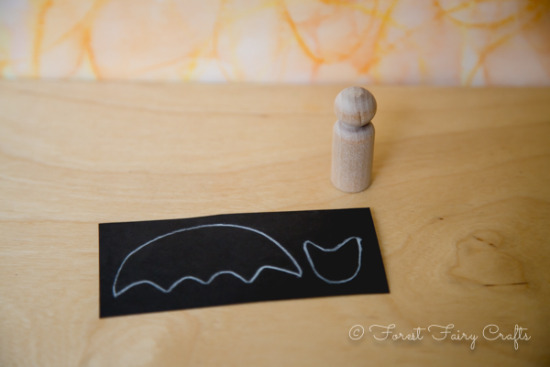
Each student had an envelope where I collected the decorated peg, wings, and head to glue at home. I used tacky glue because I added wire feet. Every bat needs to hang out!
Here was a little mistake, though, for me. I had white floral wire and thought, "this won't be so difficult to color black." Ack! I should have gone to the store and bought black wire to save myself a lot of time. If you are making one or two, coloring the wire was fun. For forty bats, not so much.
At home, I layered out the wings, head, and wire. I added glue and the peg. I let them all dry on the envelopes to return the next day.
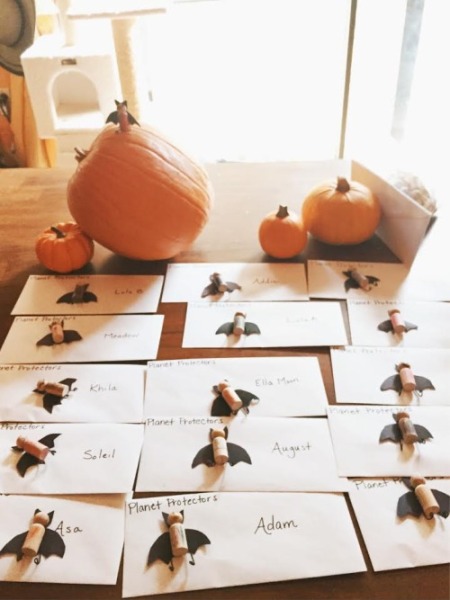
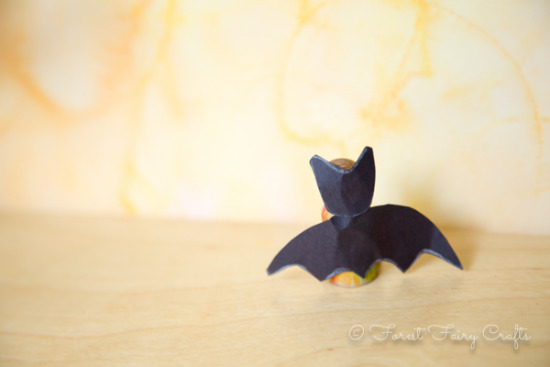
Back of the Bat
Thank you so much for the wonderful idea and tutorial, Margaret! Children loved their bats :)
Even a grumpy tree needs a little bat friend hanging about :)
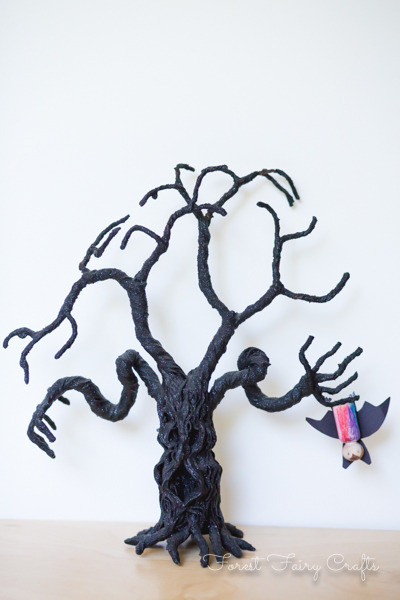
Enjoy :)
*please note: this post contains affiliate links. Should you decide to purchase a book using these links, a small amount returns to the Forest. Your price remains the same. Thank you!
Sew a Book
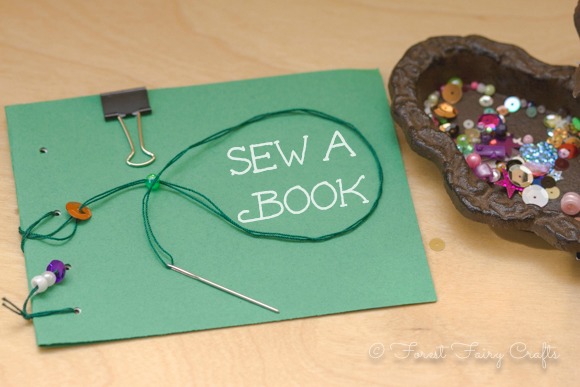
Once upon a time, books were treasures. They were kept in castles. They were guarded. And only a few very chosen people were allowed to read them. They were valued like gold and jewels. Because each and every book was made by hand. People worked hard to create paper. They lettered each word with ink and a feather. And then they had all these pages. How did they hold the pages together?
They sewed them.
Children found this idea fascinating. We looked in books to see the bindings. Most have modern glues. We did find a few with stitching.
I shared a few ideas for stitching their own books. They loved becoming authors and illustrators after sewing. I invited them to write about anything they wanted. What freedom! It could be fiction or non-fiction. A field guide to flowers in your yard or to dragons. We saw books about kittens. Books about the seasons. Books about unicorns. And books about flowers. I plan to revisit the idea and make more complex designs throughout the year. A wonderful first sewing project for all ages.
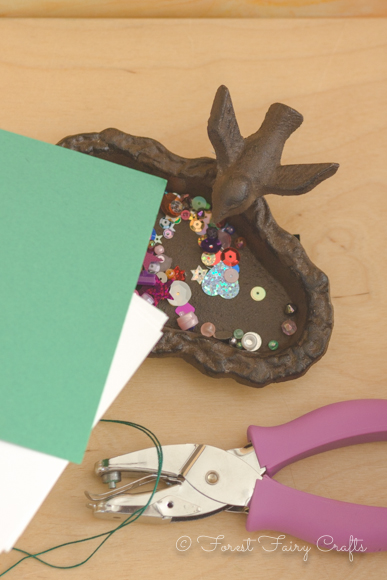
Ages
- All ages (these were with 5-8 year olds). Older children got into the history of bookmaking. They also dove into the writing and illustrating of their own stories. Younger children enjoyed threading beads and sequins.
Supplies
- Paper
- Construction Paper (or watercolor, anything for a cover)
- Needle and Thread
- Hole Punch
- Binder clip
- Sequins and beads
Preparation
- I cut the paper (any size works). I cut the construction paper so it could fold around the white paper (double the length of the white paper)
- I folded the construction paper around the white paper and secured with a binder clip
- I punched four holes along the folded binding edge. All the papers were now held together with the binderclip, keeping the holes aligned. Aha! moment :)
- I doubled and knotted thread on the needles (tips about our needle and thread choices are in our book
)
- I tied the thead around the first hole- actually went through and then back up through the loop in the thread. Any knotting will do. The books were ready for sewing!
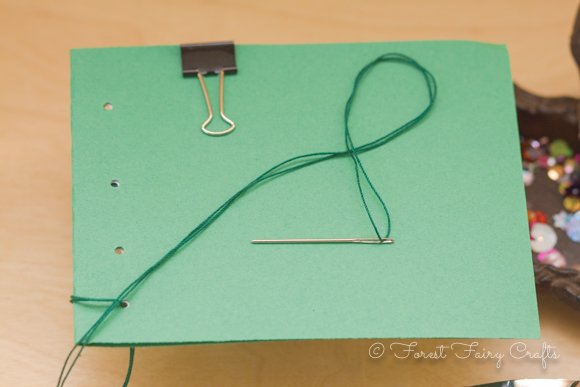
With Children
- We talked about history and sewing. We talked about taking our time. I showed how the needle can go back through a hole more than once to create a decorative binding.
- We talked a lot about not taking the binderclip off until after you sew through the holes. Pages will slip!
- Children threaded beads and sewed beads and sequins along the way.
- They discussed what they would write and draw. We talked about books with no pictures and books with no words. They really got to thinking about the process of creating a book.
I tied off threads and they drew and wrote. As long as the threads didn't wrap around the open side of the book, it was all good. They loved their books for many reasons. And wanted to make more! Which is always good. Love inspiration :)

Wishing you happy sewing today!
Please note: This post contains an affiliate link. Should you decide to purchase our book, a small percentage returns to the forest. Your price remains the same. Thank you!
Wishing Heart
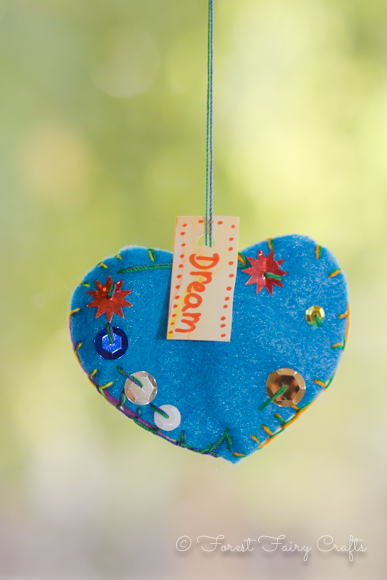
Let's begin with a wish. A hope. A dream. Let's made crafts to celebrate our wishes. Because the best wishes are from the heart.
This was my first sewing project of the year with second and third grade students (7-9 years old). Most had used needle and thread before. I wanted a project that would let them explore. A project that let everyone be successful. Whether they wanted one decoration. Or a hundred and one :)
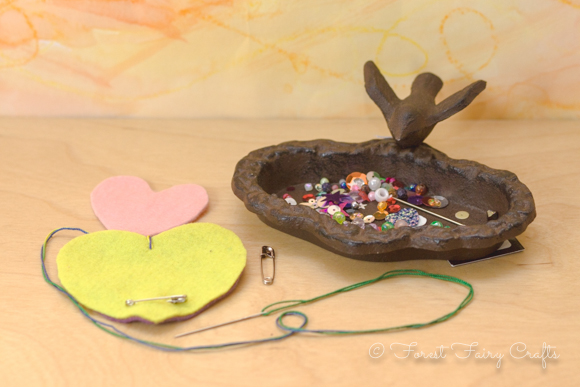
Supplies:
- Felt (two colors for each heart)
- Needle and thread (chenille needles and crochet thread)
- Safety pin
- Beads and sequins
- Slip of pretty paper for name and wish
- Optional: a third, smaller felt heart to decorate
Age: 6+
Prep: Cut hearts. Secure them together with a safety pin. Double and knot thread on the needle. Sew one stitch at the top hiding the knot between the two hearts. The stitch and the safety pin keep the felt together while children sew.
Children: These hearts are a lovely first sewing activity because almost everything is beautiful (expect for tangles). Children add a bead or sequin to one side of the heart. They push the needle through felt anywhere they like. Big stitches work just fine.
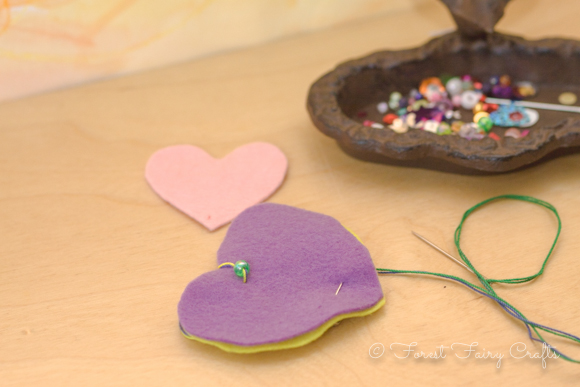
Now the needle and thread is on the other side. Add another sequin, bead, or both.
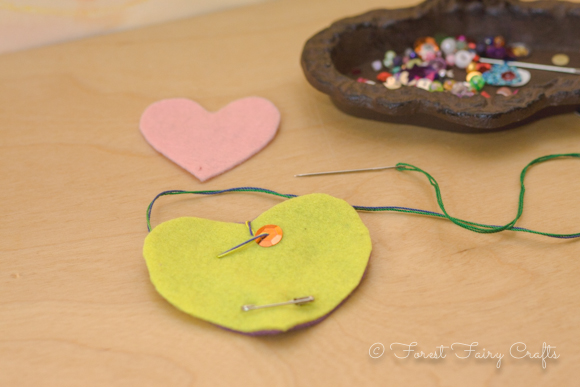
You can also add the little felt heart. Be careful when going through three layers of felt. It may take a little practice.
Add all of the sequins and beads that make your heart happy.
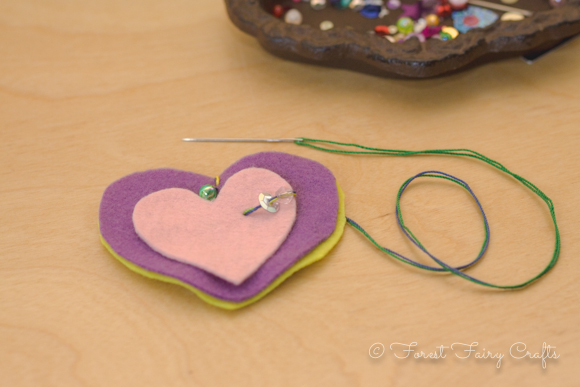
Helper: Just encourage. Sort out any tangles. Take off the safety pin once the two pieces of felt are secure.
Most design choices will be fine. Long strings of beads. Loops around the outside of the heart. Crisscross stitching. It's all okay. This allows children to experiment with sewing. And have fun! They can stitch around the outside if they like, but it's not needed.
Tie a knot. Move the string to the center for hanging if there is enough string left. If not, add a string. Many children strung beads on their hanging thread to catch the light. If beads go on the hanging thread, be sure to tie a knot around the last bead so they don't slip off.
Children: Write your name and a wish on a pretty slip of paper.
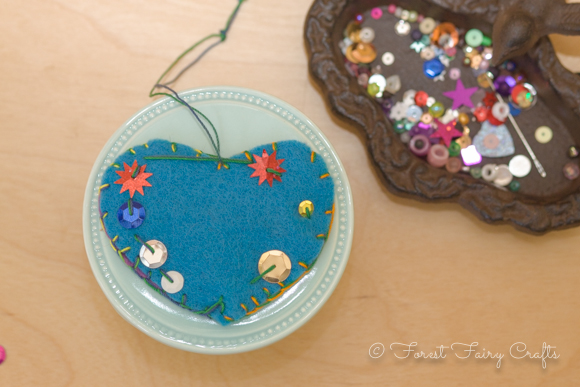

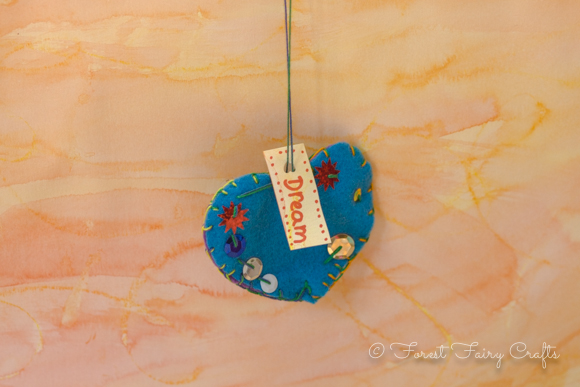
Each class hung their hearts in a special area of the room.
One is lovely. A collection is gorgeous.
Have fun sewing this week!
For more insights about sewing with children and teaching children how to sew, consider our Forest Fairy Crafts book. It shares our favorite needles and threads along with stitches, troubleshooting, and more. The link is an affiliate link. Should you decide to purchase, a small amount returns to the Forest. Enjoy :)
Wishing Stars
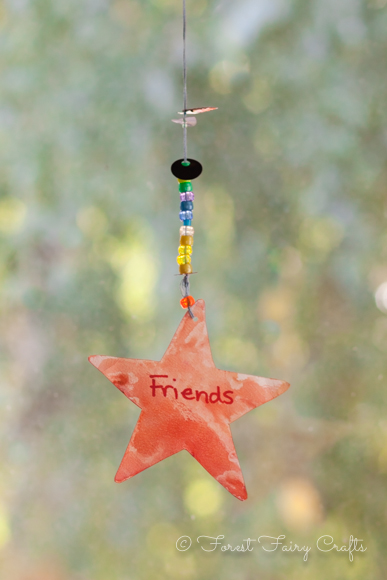
We start a journey with expectations. And children are often told "don't do this," or "don't do that," as they start an adventure (like a new school year). Think of all the rules, the rules, the rules :)
So I like to think of the things we do want for our adventure. What do we want to create? How do we want to feel? What should we bring to this journey?
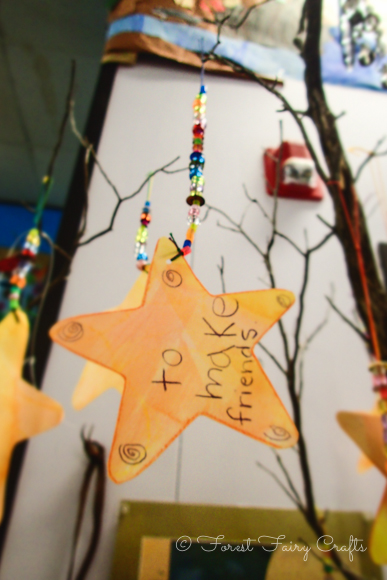
Children often wish for things. Things like ponies or candy. I want to wish for things we cannot touch. Kindness. Friends. Creativity. Beauty. Hope. Love.
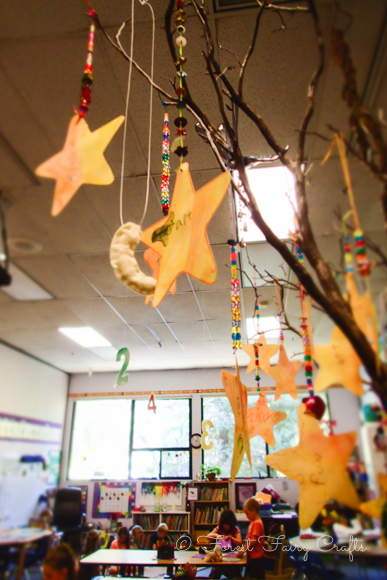
And, every once in awhile, a child cracks my heart wide open with a wish. Like this one.
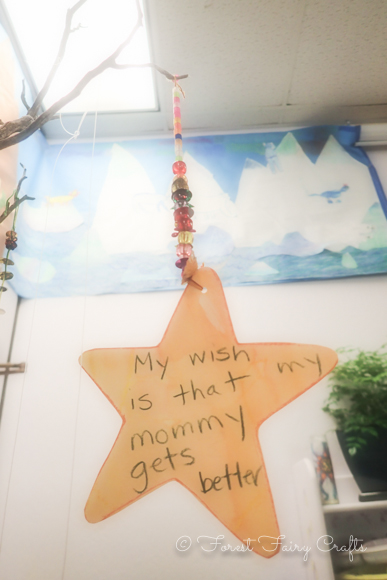
Something about crafting allows us to feel deeply. To share deeply. Creating a space where we can express ideas that are big and mighty. They connect us. As we sew or bead or knit, we create together. We create community.
The stars can be very simple or made fancier.
Optional: Children can watercolor or decorate their own paper. We have painted squares on both sides, then we cut into stars. For time's sake, I watercolored and cut these stars.
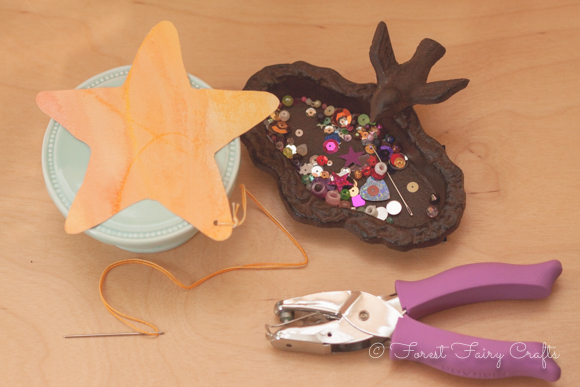
Supplies:
- Stiff paper
- Needle and thread (I used friendly blunt needles and crochet thread)
- Beads and sequins
- Hole punch
Prep:
Watercolor paper on both sides and punched a hole. Double the thread and tie a knot. Go through the hole, then back through the loop in the thread. The thread is now attached to the star and ready for decorating.
Ages: 5-7
For children:
Write name on one side of the star and a wish on the other side. If a wish is hard to choose, add a few beads while thinking. Wishes can take time. Decorating the star is also lovely. Thread sequins and beads. Hang in a sunny place to see the sun shine on your wishing star.
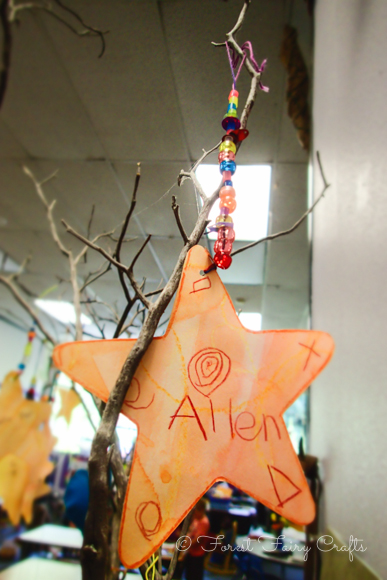
Helper: When tying off, be sure to tie around the last bead, or else they can all slide right off the thread. I loop the needle through the last bead a couple of times to secure all the other beads on the thread.
Enjoy! One class hung them on a branch. Another hung them from the ceiling over their gathering space. All those wishes watching over the children. Beautiful! These inspire a lot of discussion and create a lovely space where children celebrate wishes coming true :)
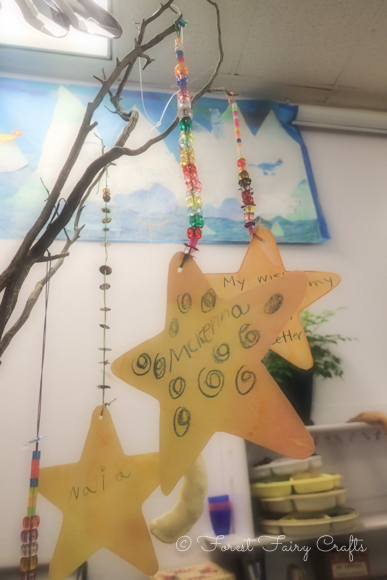
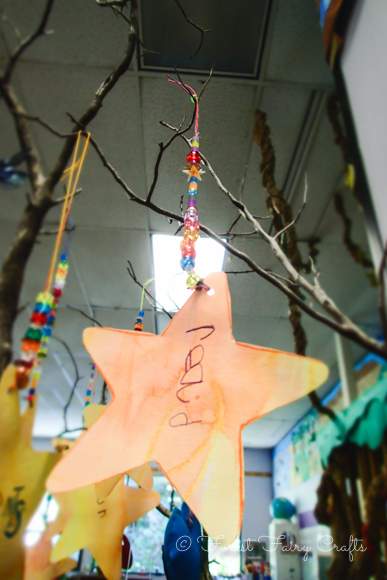
This wish? To read. May all your wishes come true :)
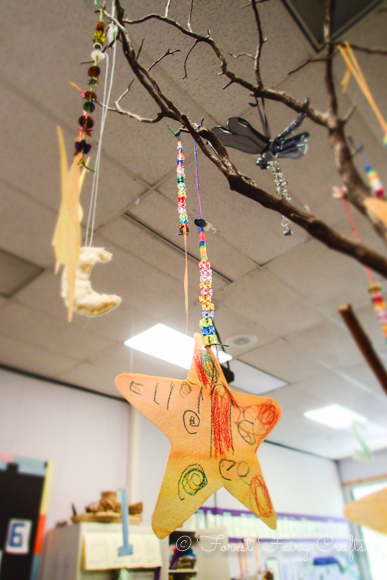
The First Forest Beasts
The Forest Beasts are here!

We had such fun designing these softies. The kids chose all the shapes and colors. I helped with the sewing machine- especially with the faux fur. That material is hard to sew!
I am inspired to think of easy, early tricks for sewing machine skills. The kids loved seeing their ideas become real life cuddle-monsters :)

These may be the first, but they sure won't be the last beasts :)
PS- Ian had a friend visiting. These were just as fun for the boys as the girls. A great boy craft! *Not that I believe certain crafts are for "boys" or "girls". I just see how they respond to different ideas. And the boys (and girls!) loved this one!
Tie Dye Adventures
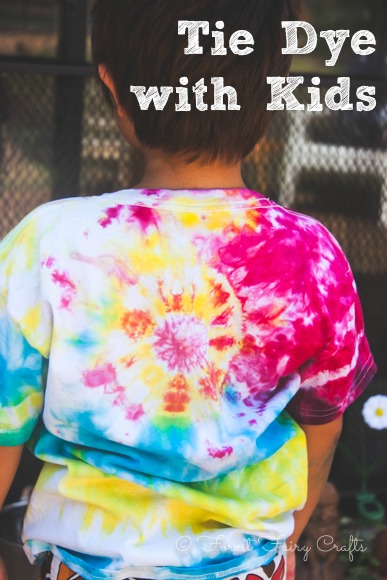
Tie Dye is timeless.
Seriously. I thought tie dye might be a fun glimpse into my college years. I could share an activity from my youth. I learned that what felt "dated" to me was "all new" to them. And they LOVE it. The process was magic.
And they learned a lot along the way :)
So we started with the Jacquard Funky Groovy Tie Dye Kit. The kit came with directions, dye, rubber bands, and one pair of gloves (which became imortant later). We looked online for inspiration. We learned a few different techniques for using the rubber bands. Anika tried a swirl. Mila wanted a stripes. Ian wanted a bullseye.
They each had a t-shirt and a white tea towel/flour sack which was thin cotton. The Flour Sack Towels were a surprising hit. They are used as doll and stuffie blankets, dancing scarves, and decorations. We found them on a whim and I'm so glad that we gave them a try. Each child got a shirt and a scarf.
Anika (11) could manage the rubber bands on her own. For Mila (6), I encouraged her to loop the rubber band once, then I cinched each one with a few more loops. Ian (5), pointed to where he wanted the rubber bands and I put them on for him. When they were done, we placed plastic bags in the shade (one for each child). I've dyed before, so I know what happens when projects are close to each other (dye easily puddles and moves to the other project). So we gave each project plenty of room.

The kit came with red, blue, and yellow. And one pair of gloves. I let Anika wear the gloves. She started with the dye. Then I wanted to have fun, too. We planned to jump in the pool afterwards so using a little without gloves would be fine, right?
Wrong. My hands were dyed for days! My fingernails, especially, looked like monster-hands all yellowed and green. Next time, I will get extra gloves :)
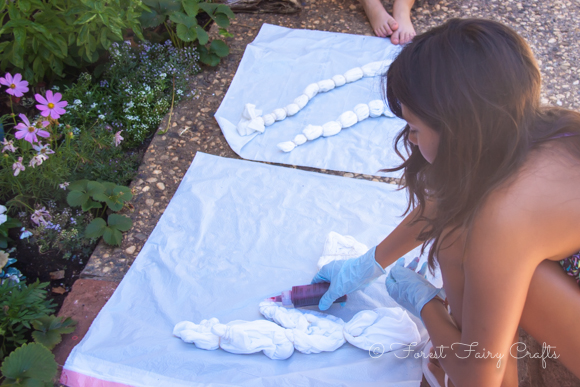
Anika and I used the bottles while Mila and Ian told us where to add the colors. We were careful not to let the dye puddle underneath the project (keeping each area the chosen color).
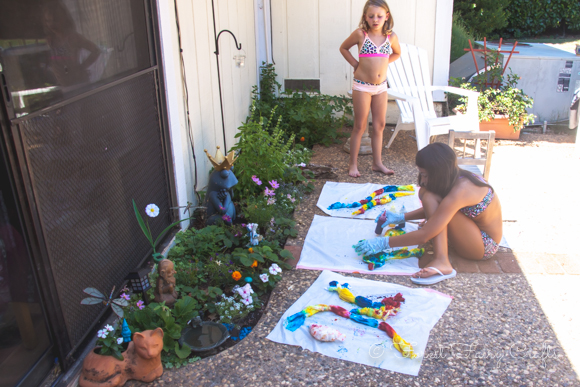
After awhile, mixing became fun too!
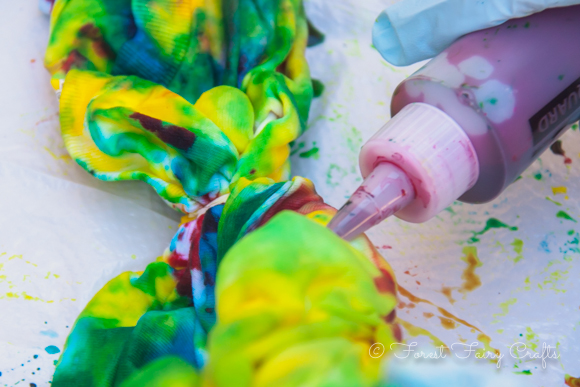
The colors were so vivid! And the directions had a lot of illustrations, which Anika appreciated. I asked her to read a lot of them to me, so information reading practice, hurrah.

Oh, one idea was to place marbles or bouncy balls inside the fabric before adding the rubber band, thus creating the bulls-eye effect. Fun stuff. We searched Pinterest and found lots of inspiration :)
We had extra dye when the kids finished. And a couple of four sacks. So I decided to dip-dye. I asked the kids to predict what would happen. I found old containers that I wasn't worried about ruining. I draped the towels over a child-chair (that I also wasn't worried about ruining). And we tucked a few inches into the dye. Science! What might happen and why?
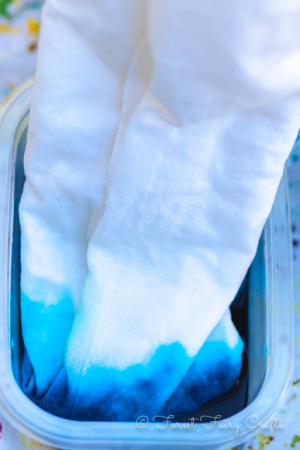
By now our workspace was nice and messy. So I made sure that nothing sat in a puddle of unwanted color (brown) and we left everything to sit. This was hard for the kids because they wanted to open their creations right away. I can understand that! Practice patience :)
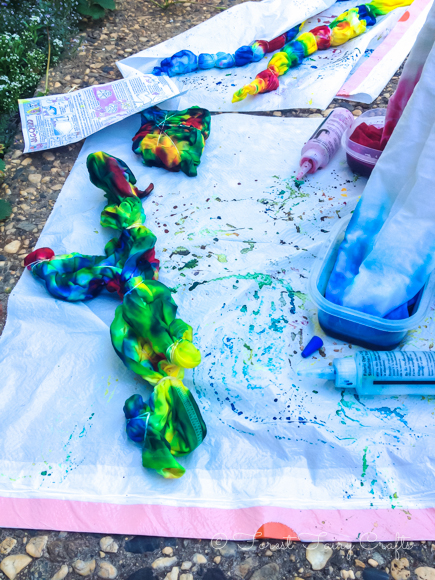
And by now my hands were a mess! Oh, you can see the fun directions in this image. Perfect for older children.
We let the projects sit. And sit.
The dip dye started its science-magic.

We looked up how water can travel "up". We let everything stay overnight. The next morning, the blue had traveled up half of the towel! I didn't get a photo of that, sorry.
The kids were amazed. Then I wore the gloves (I learned my lesson the hard way) to snip the rubber bands carefully and rinse excess dye. The kids were thrilled by what they had created. Awesome!
I held their projects up for them to admire, then tossed everything to wash and dry (as instructed). Finally, the shirts were ready to wear.

Each one turned out different. Exactly like the kids who made them :)
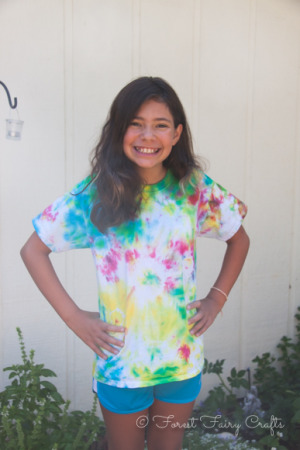
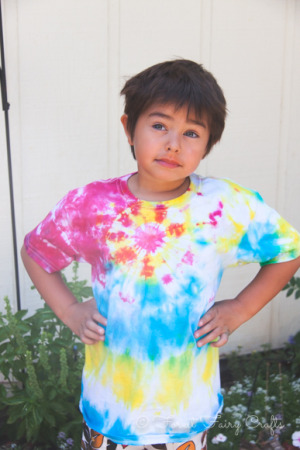
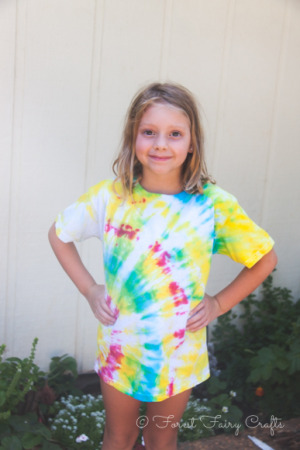
These child-led crafts are delightful and rewarding for them. Look what can be made!
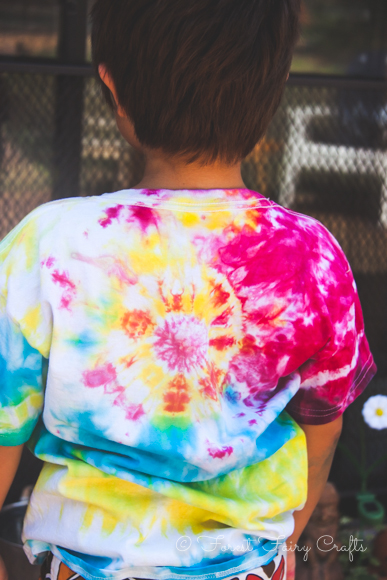
I remembered why I wore so much tie-dye in college. It's fun!
Ian loved the activity as much as the girls, so this is definitely fun for boys and girls. The best part is that, every time they wear the shirts, they remind us of happy times. And that never goes out of syle :)
This is not a sponsored post, but the links are affiliate, so if you decide to try your own tie-dye adventure, a small percentage returns to the Forest. Your price remains the same. Thank you!
Happy dying!
I completely forgot! We made these a couple of weeks ago. The kit comes with Soda Ash, which is mixed with warm water to soak the clothing to prepare for the dye. Lots of opportunities to practice patience. I followed the advice to save the soak after taking the clothes out (all in the directions) so I could easily dunk a couple of extra scarves when we had left-over dye.
Figured I should let you know that we followed that step :)
Have fun!
The Children's Festival
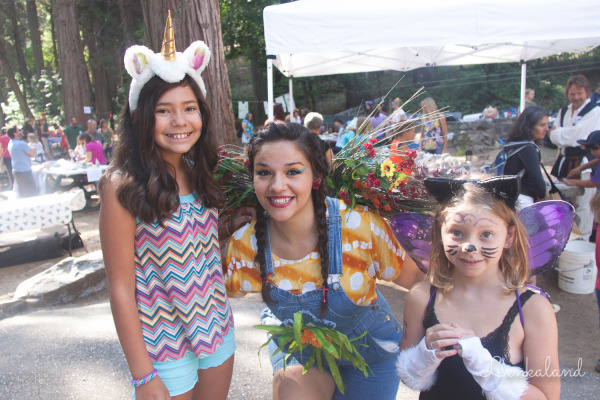
Another year of magic!
The Children's Festival is a community celebration of childhood and adventure. We dress up as unicorns and kitty-fairies and (this year) Superman :)


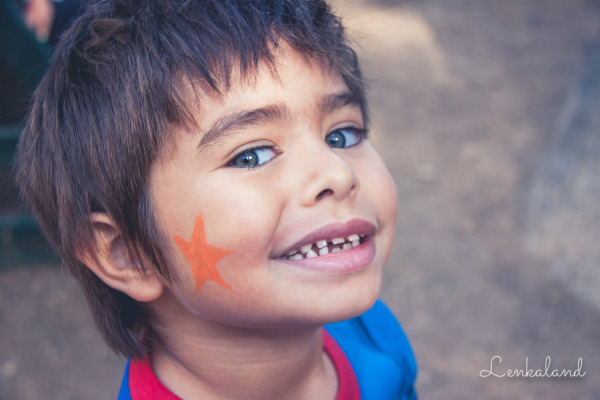
Magic can be so simple in childhood! The highlights of the festival include facepainting using watercolors (always check paint for whether it's safe and appropiate (not permanent :)).
Clay and painting a giant cardboard castle and hammering scrap wood to make daggers and swords and little houses.
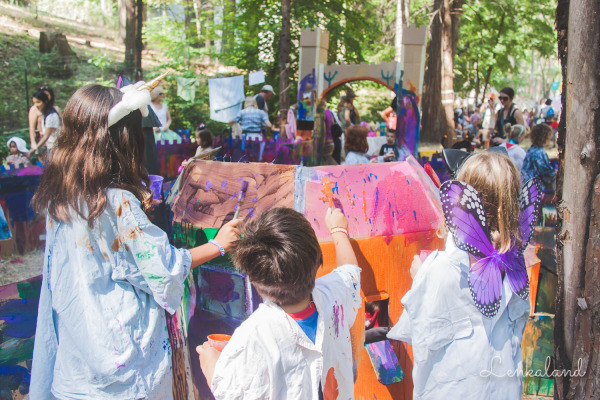
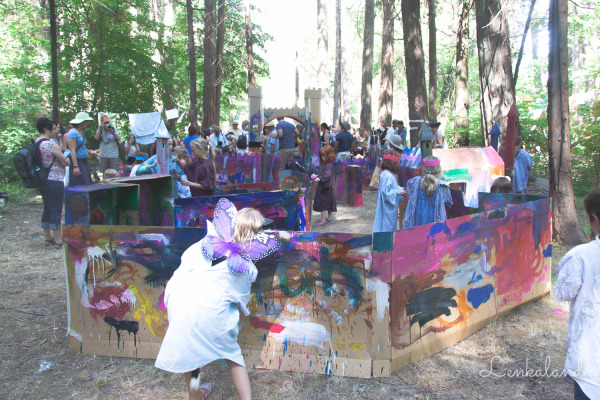
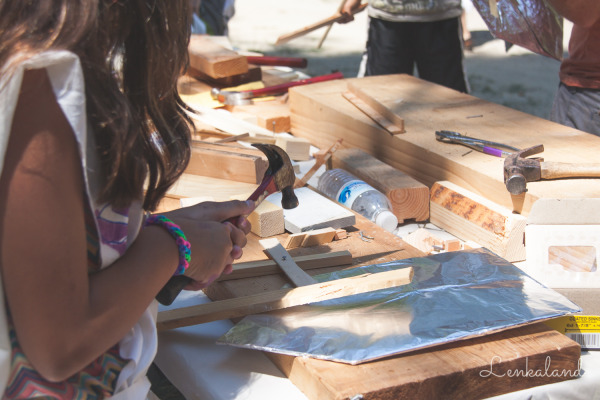
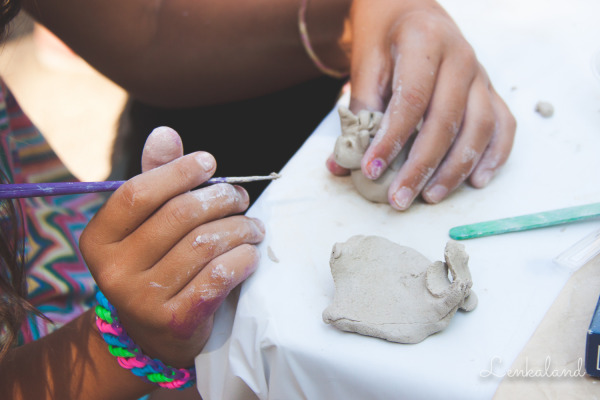
Children create their own magic! They become vivid characters with a few simple ideas. We are surely lucky to have dedicated volunteers who make these dreams possible.
Oh, and the favorite treat! I almost forgot!

A lemon with a stick of peppermint. You suck the lemon up through the peppermint. The candy becomes a sweet straw. The kids love this treat! We had to go back for second lemons. When life gives you lemons, make easy peppermint lemonade :)

Simple things that make magic for children. I may use a few ideas at our next party :)
The Festival, however, takes magic to another level with the many volunteers who go above and beyond to make an unforgettable adventure!
The bride is guarded by a Troll who demands a stick or rock for toll. The children search for the best items to give him. He has red eyes and a spider on his nose!
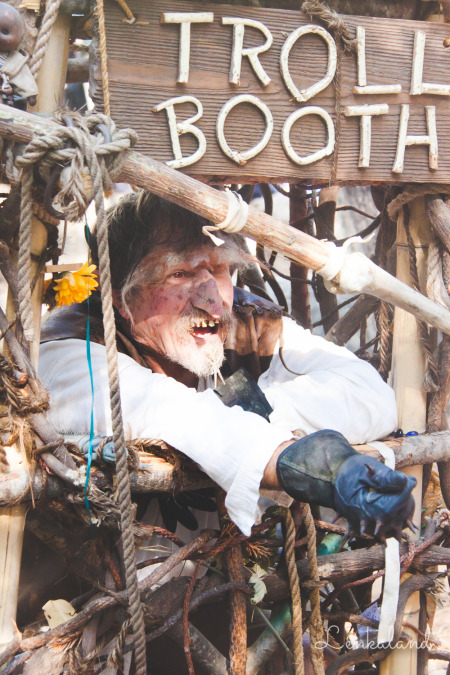
And a real fire-breathing dragon!

The entire day is an experience! We can't wait for another journey to the enchanted forest next year!
The entire gallery with lots of photos is here:
Go to The Children's Festival on Facebook for updates about next year's event. Inspiring children (and adults) every year :)
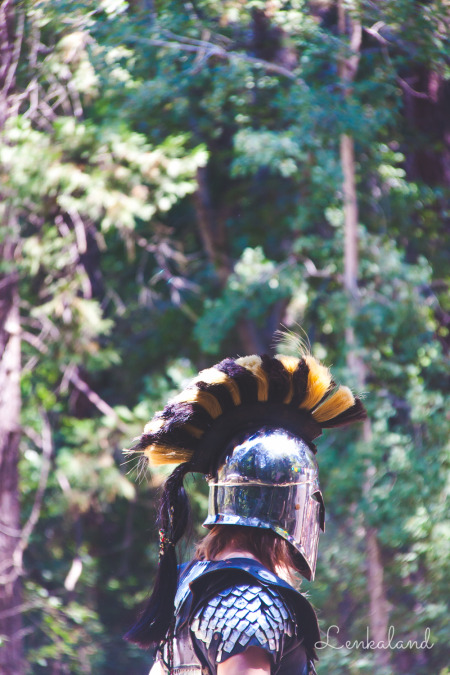

Off to Neverland! Or the Enchanted Forest! Or ... ?
:)
Happy Fourth of July!
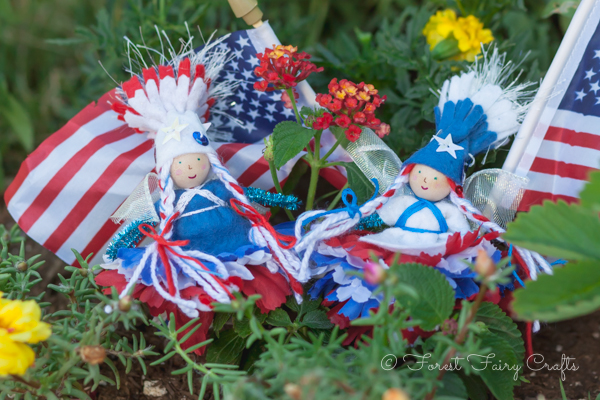
Hello fairies!
This week we made fairies to celebrate the Fourth of July. They are so festive and fun!

We were inspired by carnations in the craft store with red, white, and blue petals. We found great supplies with my Christmas collection of pipe cleaners, sequins, and sparkly threads. We realized that pompoms make perfect fireworks :)
So we sewed the design of the Leprechaun Hat with a long top (layered with another color). We tucked the pompom inside. Magic :)

Ian made a boy that had Fireworks Power. The blue thread going down his arm is how he shares his power to make fireworks.
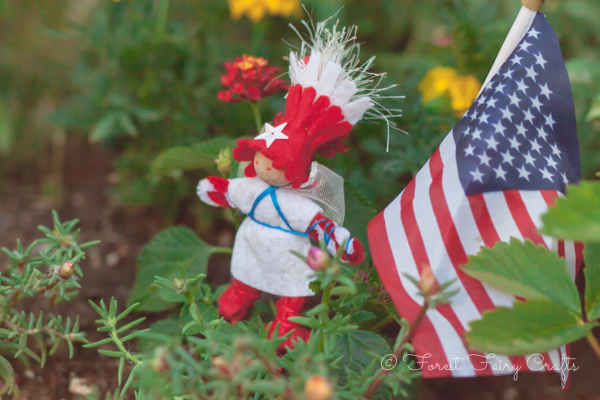
And he wanted an orange face. This boy loves orange (he has a collection of All Things Orange by his bed).
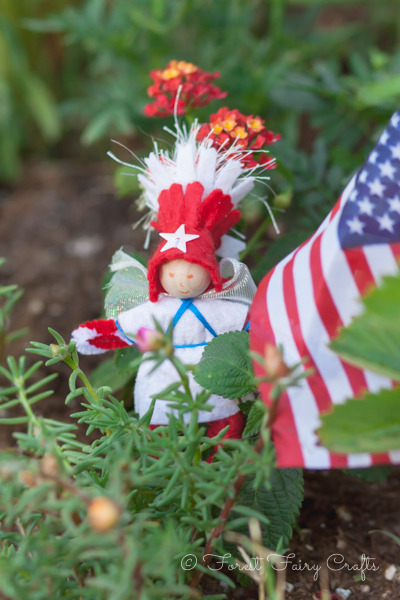
We have a big party today (it's my birthday!) so I better go decorate :)
Enjoy the holiday! Happy Fourth of July! Happy Fairy Crafting!
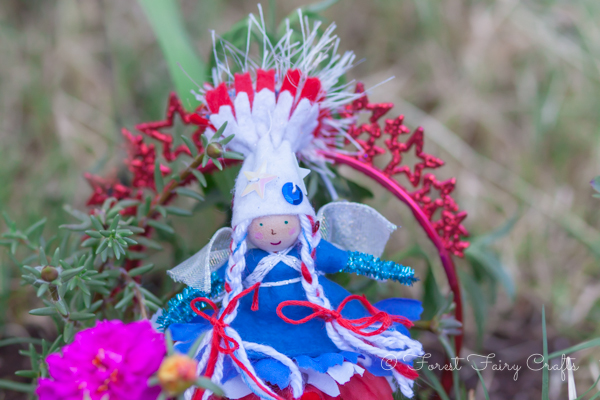
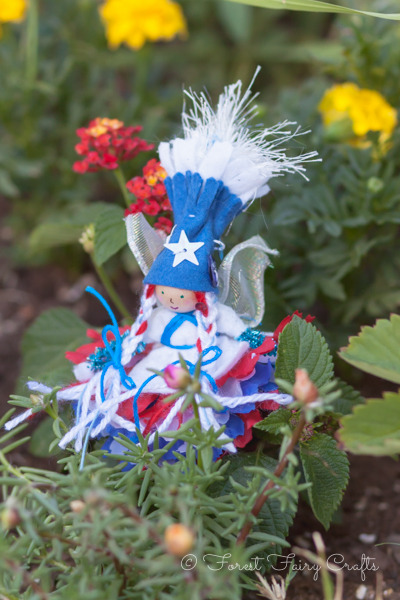
Peg Doll Swap Fairies
These fairies inspired me! I joined the Peg Doll Swap at We Bloom Here. My partners were the super-talented Maureen from Twig and Toadstool and Jess from Bits and Bobbins/Mosey Handmade. How lucky am I?
Not only did I get to connect with these amazing crafters, they inspired me to make fairies for their families.
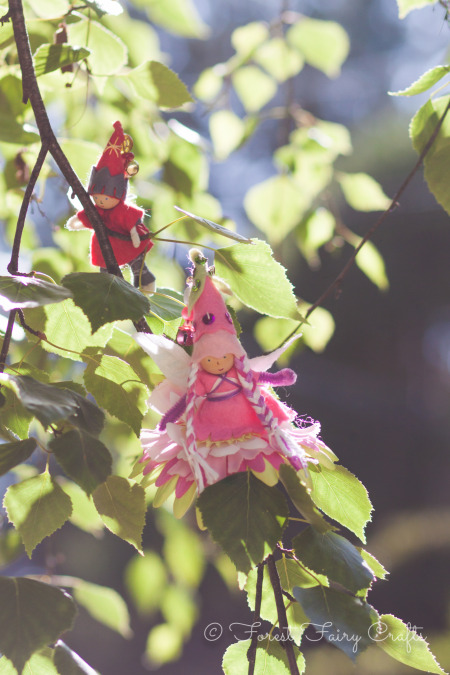
Crafting for children is a treat. As a crafty mama, my children often see me create and send treasures to other people. I make sure to set a few aside for them, of course. I saw the swap as an opportunity to give a personalized fairy to the children of crafty-mamas. I asked their favorite colors. I created a little brother/big sister, and little sister/big sister for my new friends.
The curious thing was that favorite colors were red/pink, and pink/red so the fairies matched in opposite ways :)

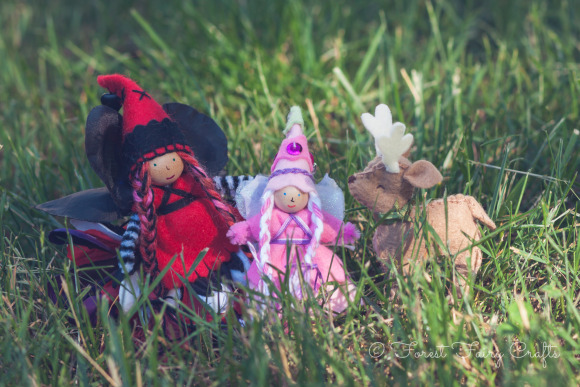
The darling deer is our new forest mascot sewn by Margaret Bloom just for us :). We love our deer friend!
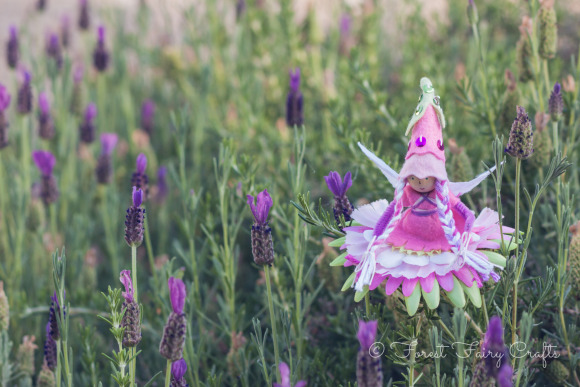
The fairies are on their way to homes in Maine and Ontario, Canada. I bet they will go on many adventures with their new friends!
Playing with Craft
Children love inspiration. Don't we all?
Making toys inspires children. They delight in the power of their hands and ideas. I recently sewed these lovely baby leprechauns with six year old students. Children sewed all their own sequins, around the fairy baby, and added stuffing. They were delighted with the little toys they made.What a treat, to see that magic through their eyes. Look what we can create!
Sorry this one is a little blurry- classrooms have tricky lighting for my camera :)
Then the children reminded me the real fun of sewing and crafting. Crafting is inspiration. And the craft is just the beginning. Crafts inspire play. And play inspires storytelling. And learning.
Now that they had little friends, they needed houses. What could build a house?
Blocks of course!
And some homes need a diving board into a lovely cool pool.
With a luxury view from the bedroom.
Legos also make awesome homes. With an open door :)
I encourage students to leave blank faces so they can imagine any expression, but a few insist on adding features. I let go when they have strong feelings towards needing eyes or mouths. After all, if I wanted it to look 'my way', I would make my own :)
I loved her idea to put a ring over the ruffled hat for an even fancier crown.
And finally, dollhouses are wonderful homes. Especially when they come with a pet tiger :)
Enjoy what you create!
Happy day :)
Many of our crafts are "Keepsake Crafts", meaning they look nice for years and become a treasured memory alongside the sweet sewing. Every now and again, I sew "Process Crafts" with children. These are the crafts to shove in pockets and forget outside after playing in the trees. They are the crafts that are meant for playing. They are a chance to let go. Don't worry overmuch about colors or forever. Let them become a memory. Become part of a story. Have fun crafting and playing :)

P.S.- if you would like detailed directions for making little fairy/gnome friends, check out our Forest Fairy Craft Book. Please note- is an affiliate link. Thank you from the forest should you decide to purchase one! Directions for the little hats are online here. Enjoy!
